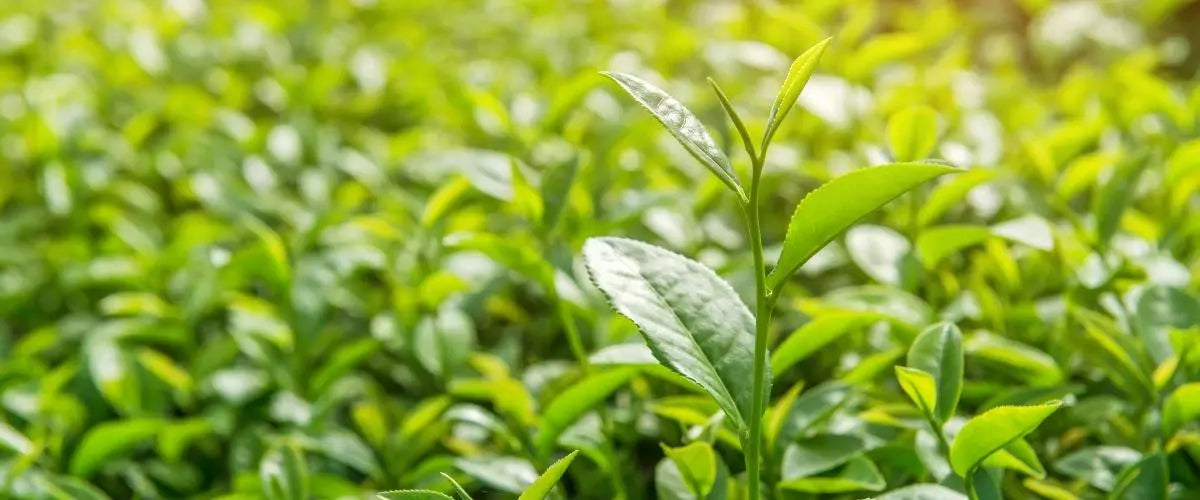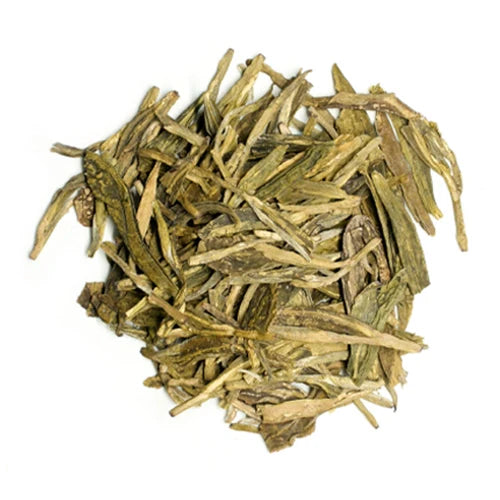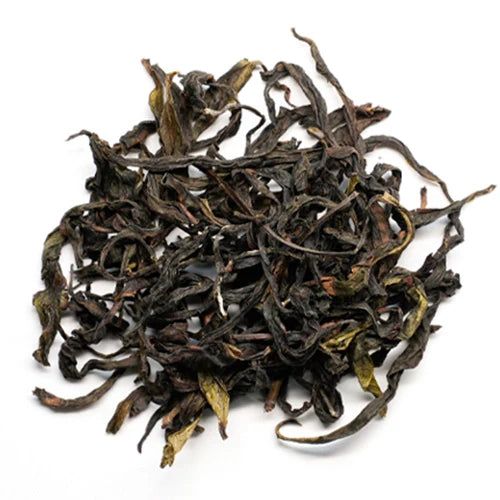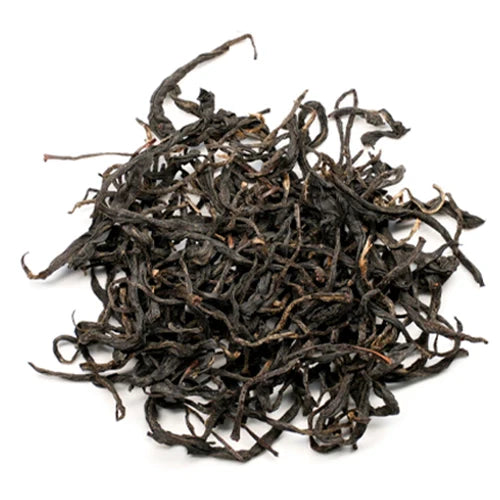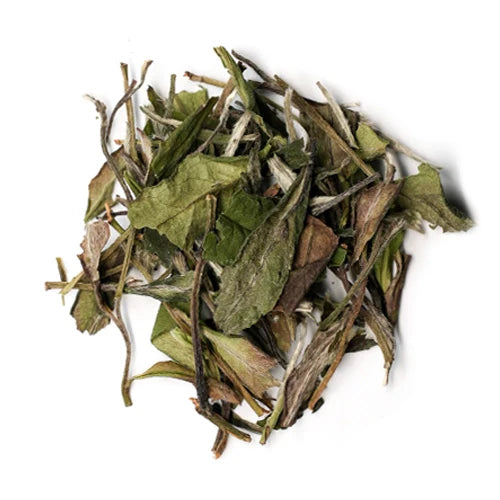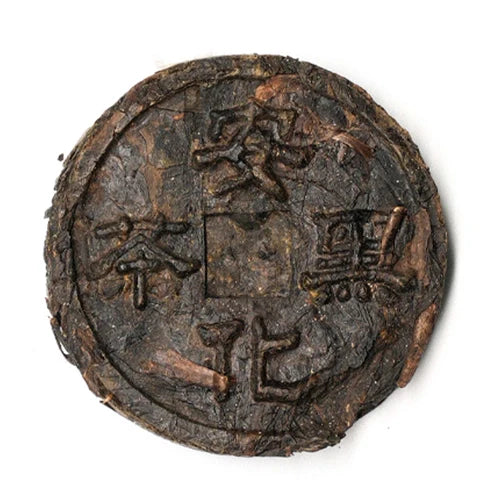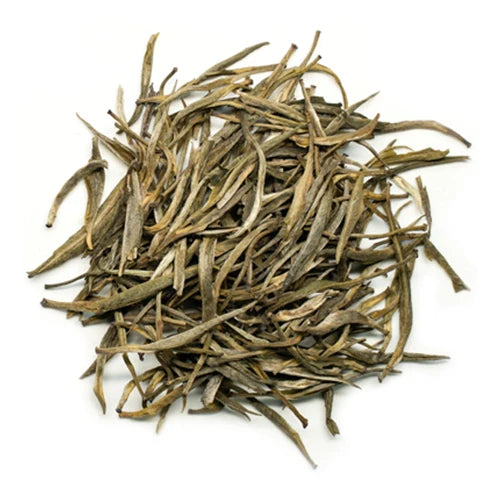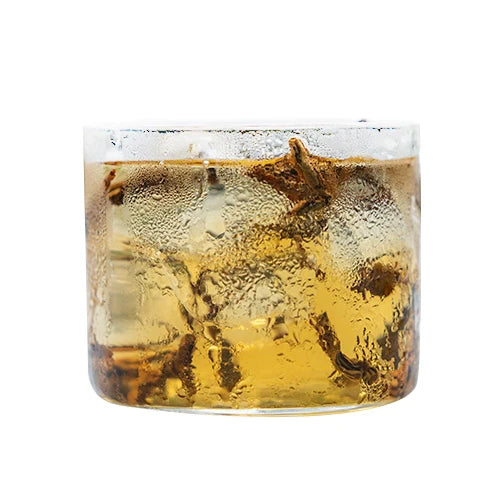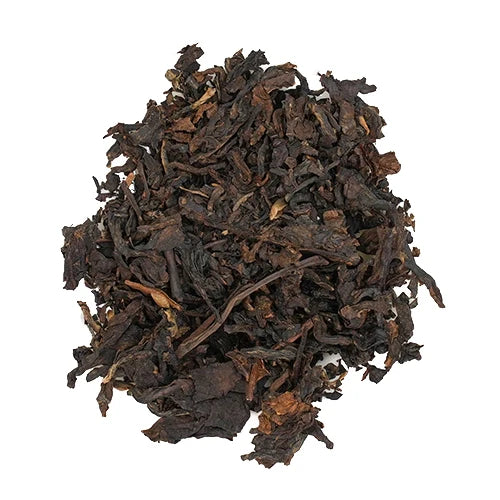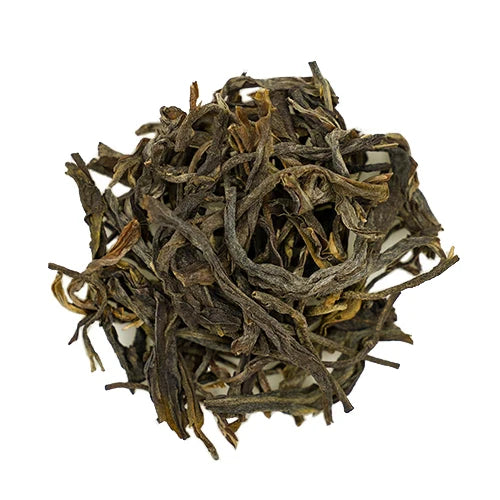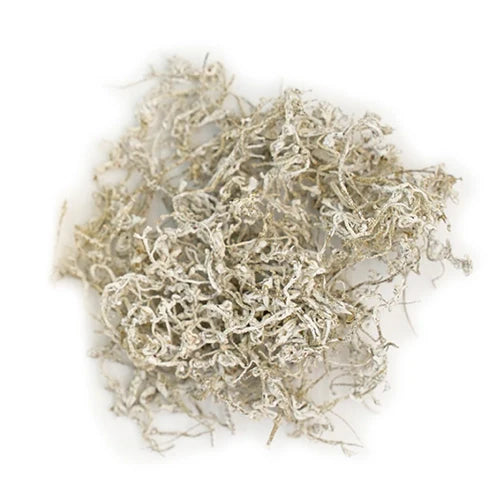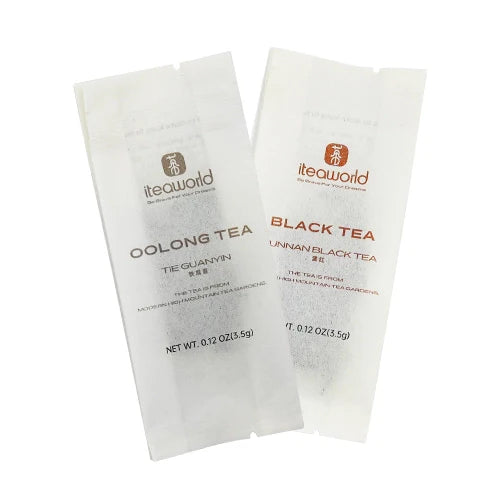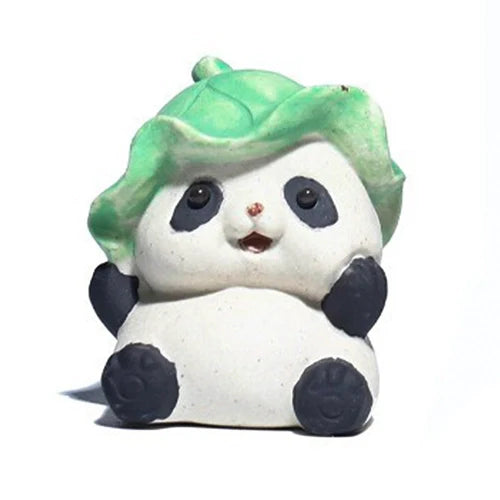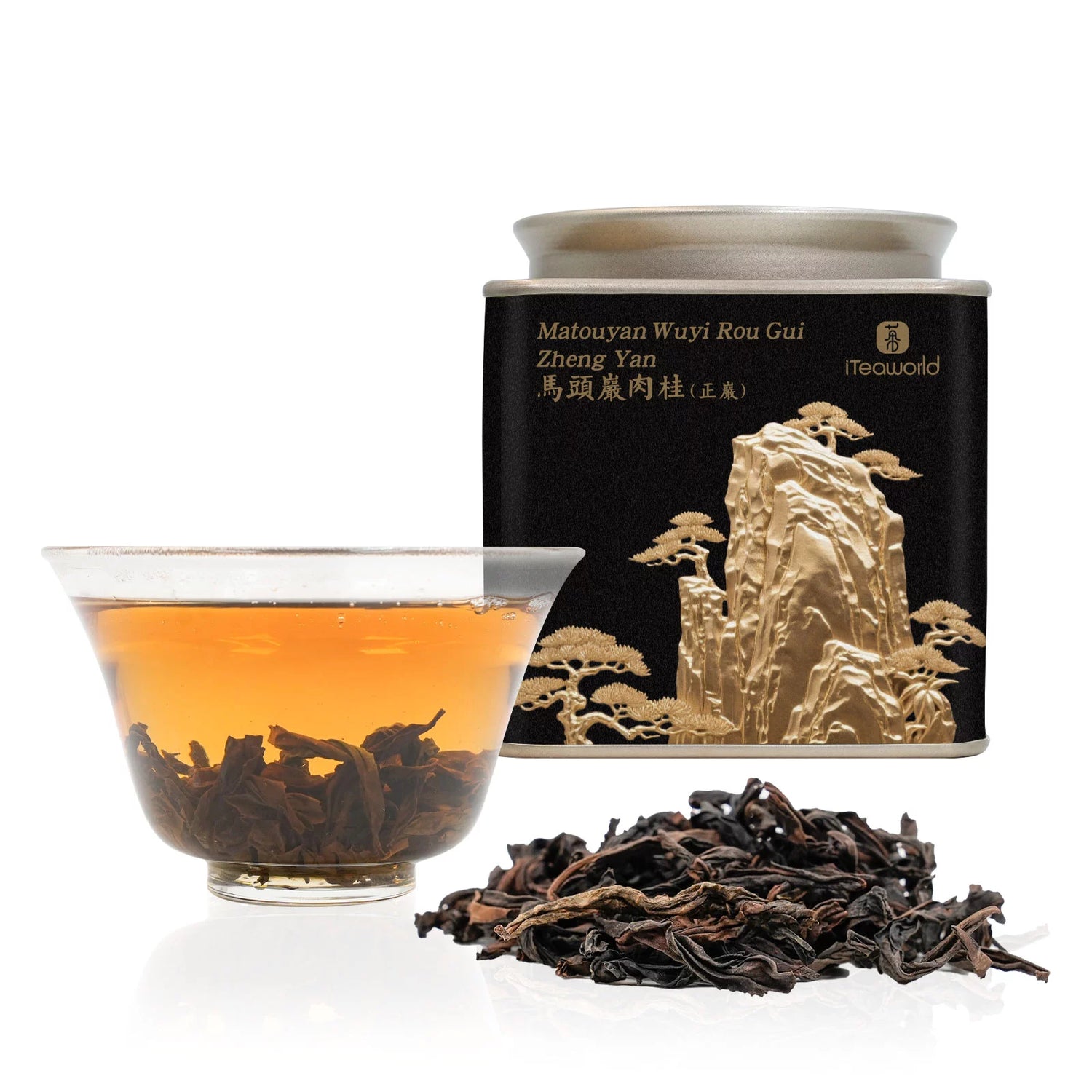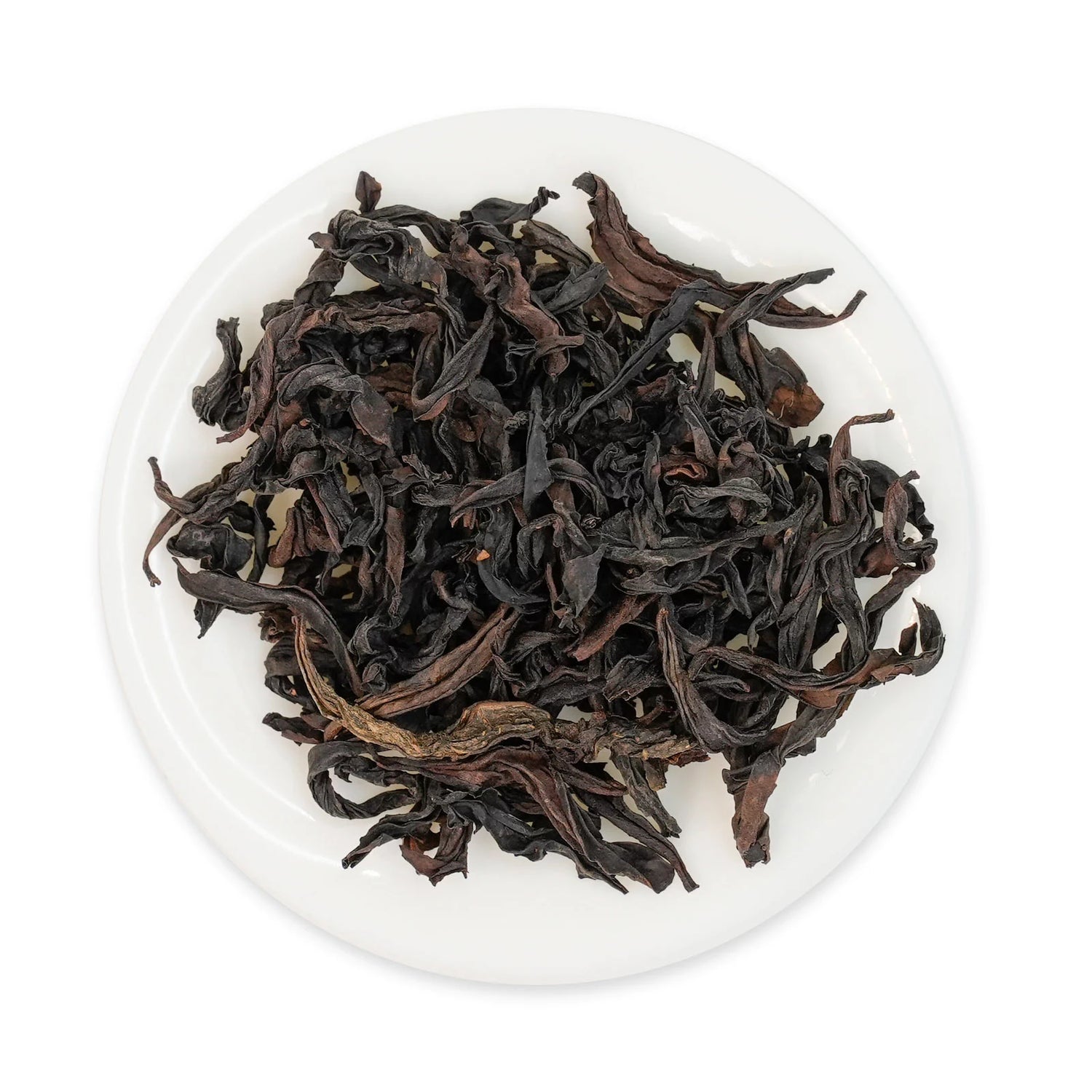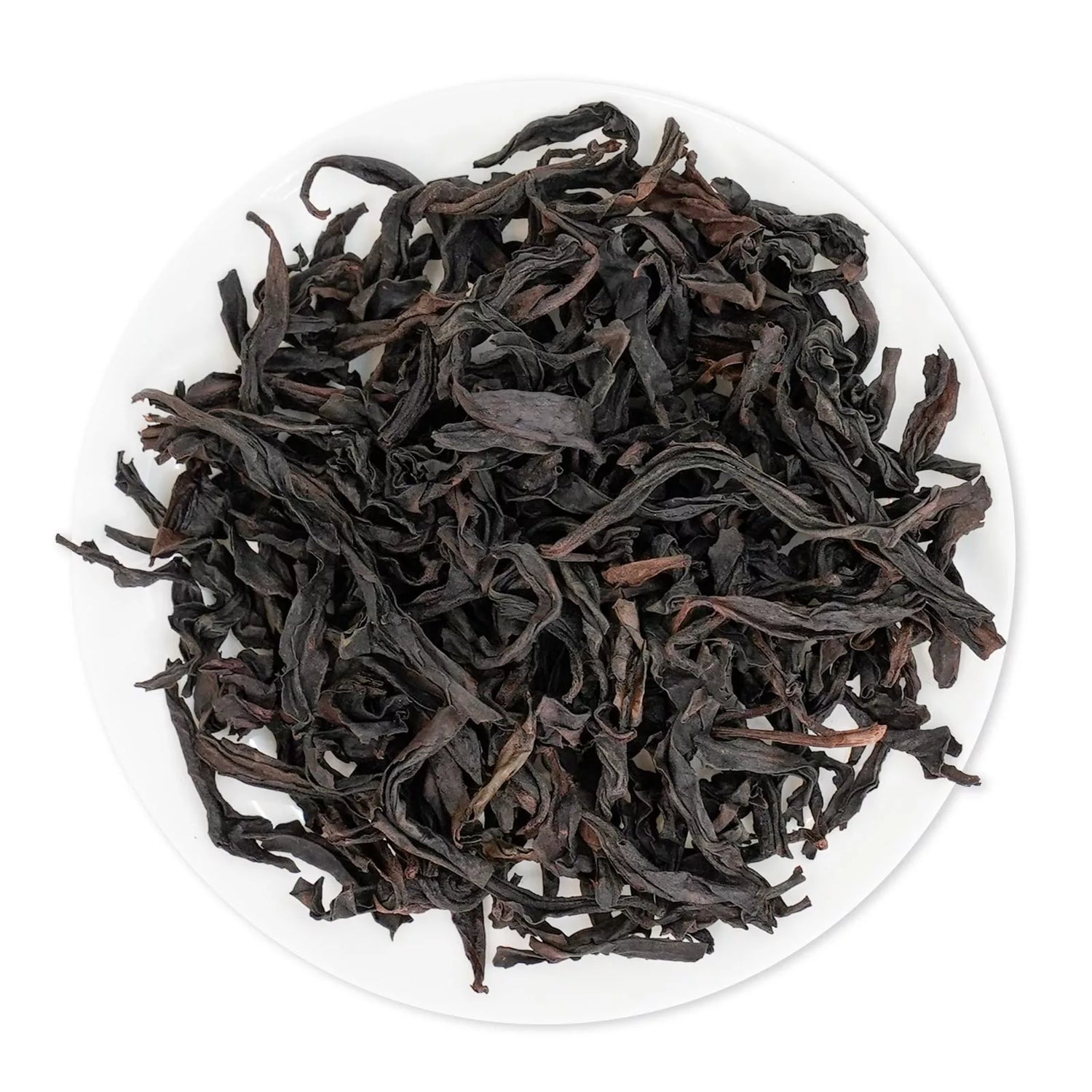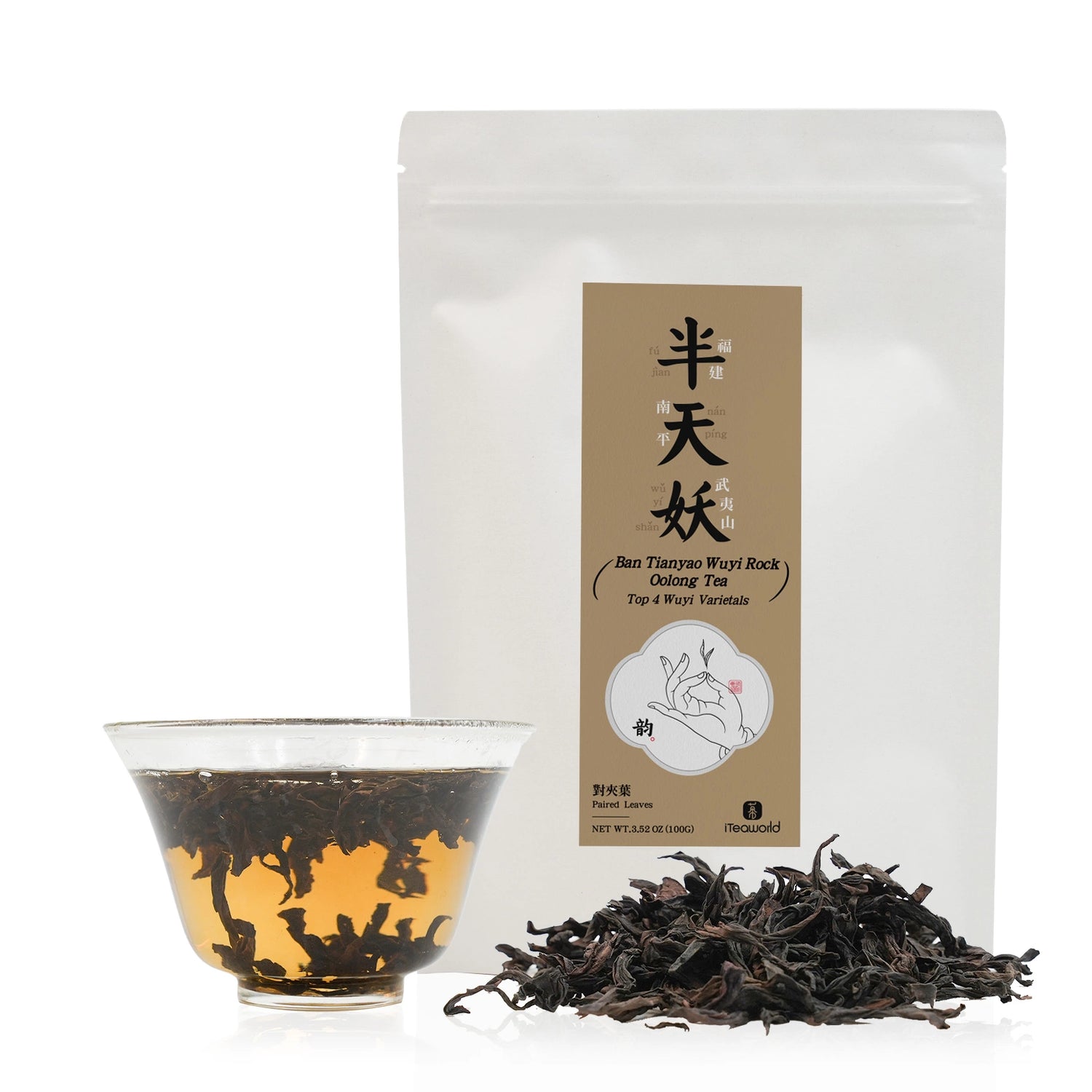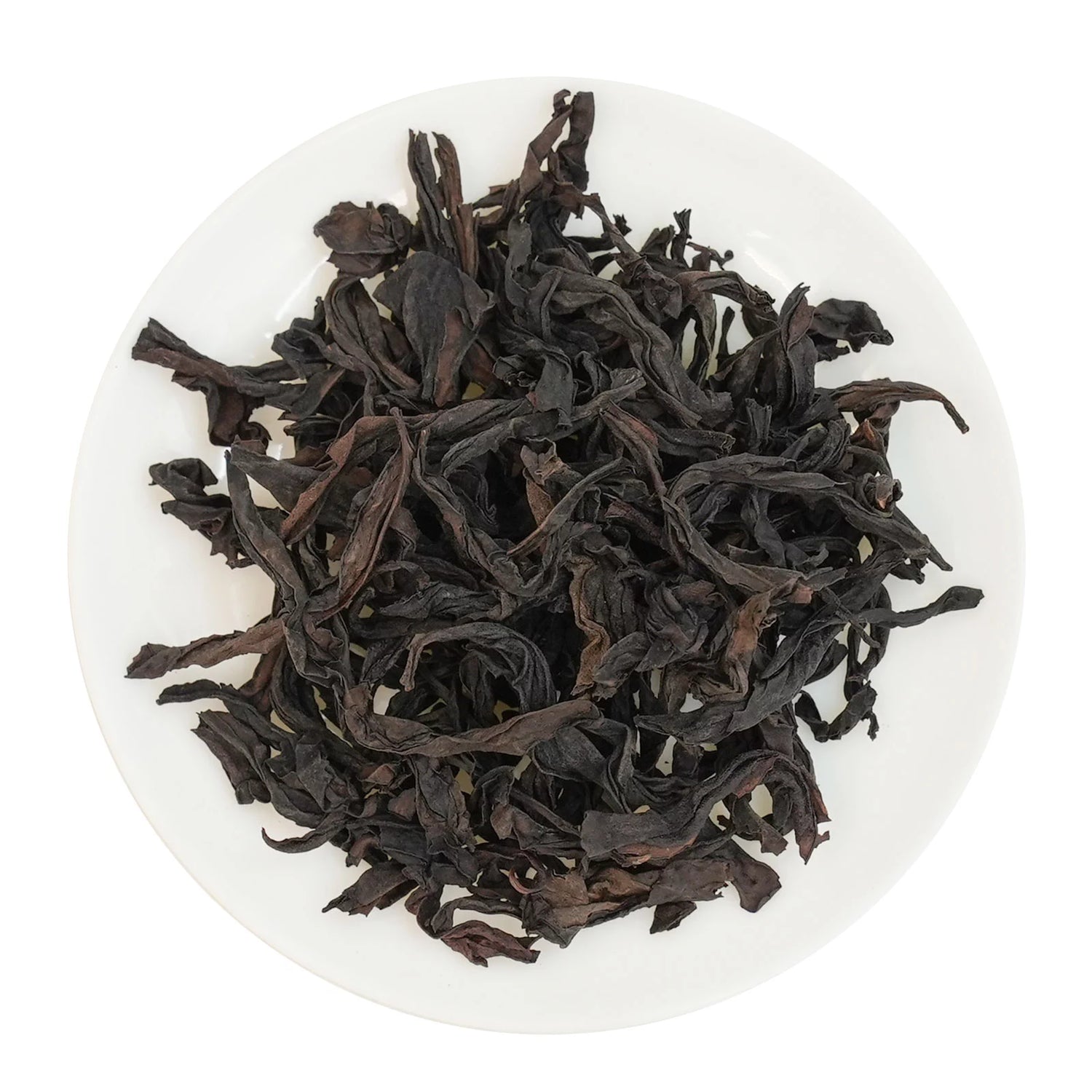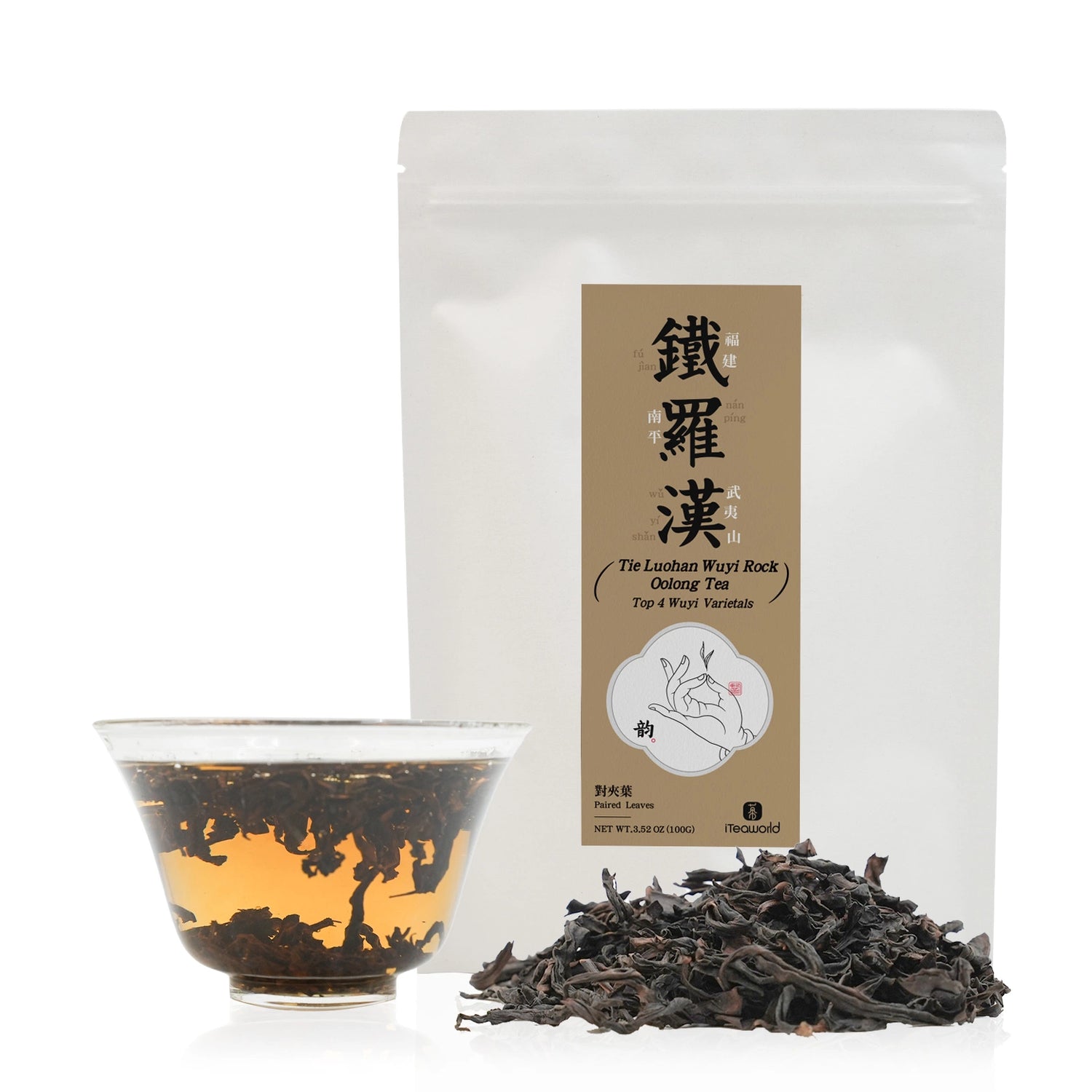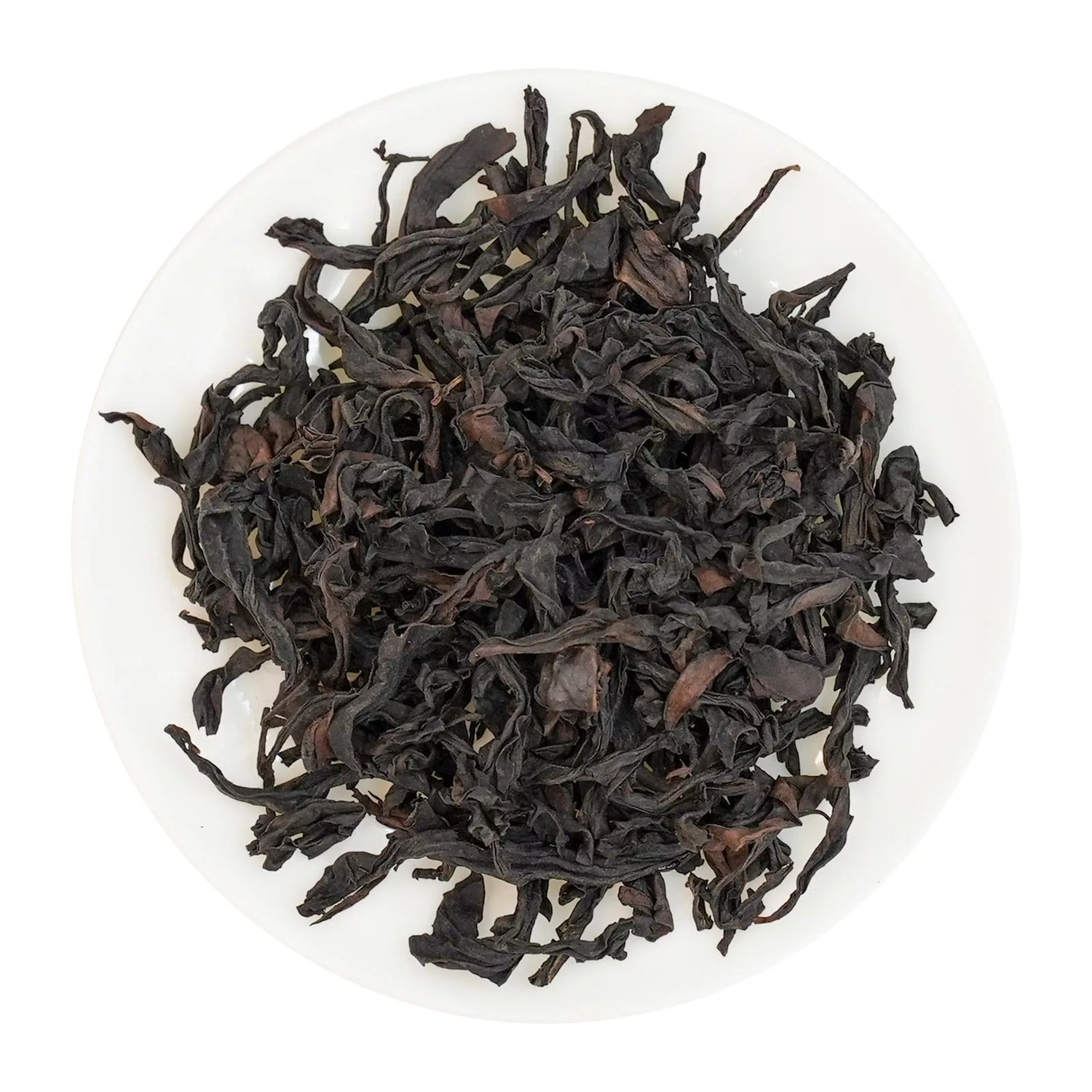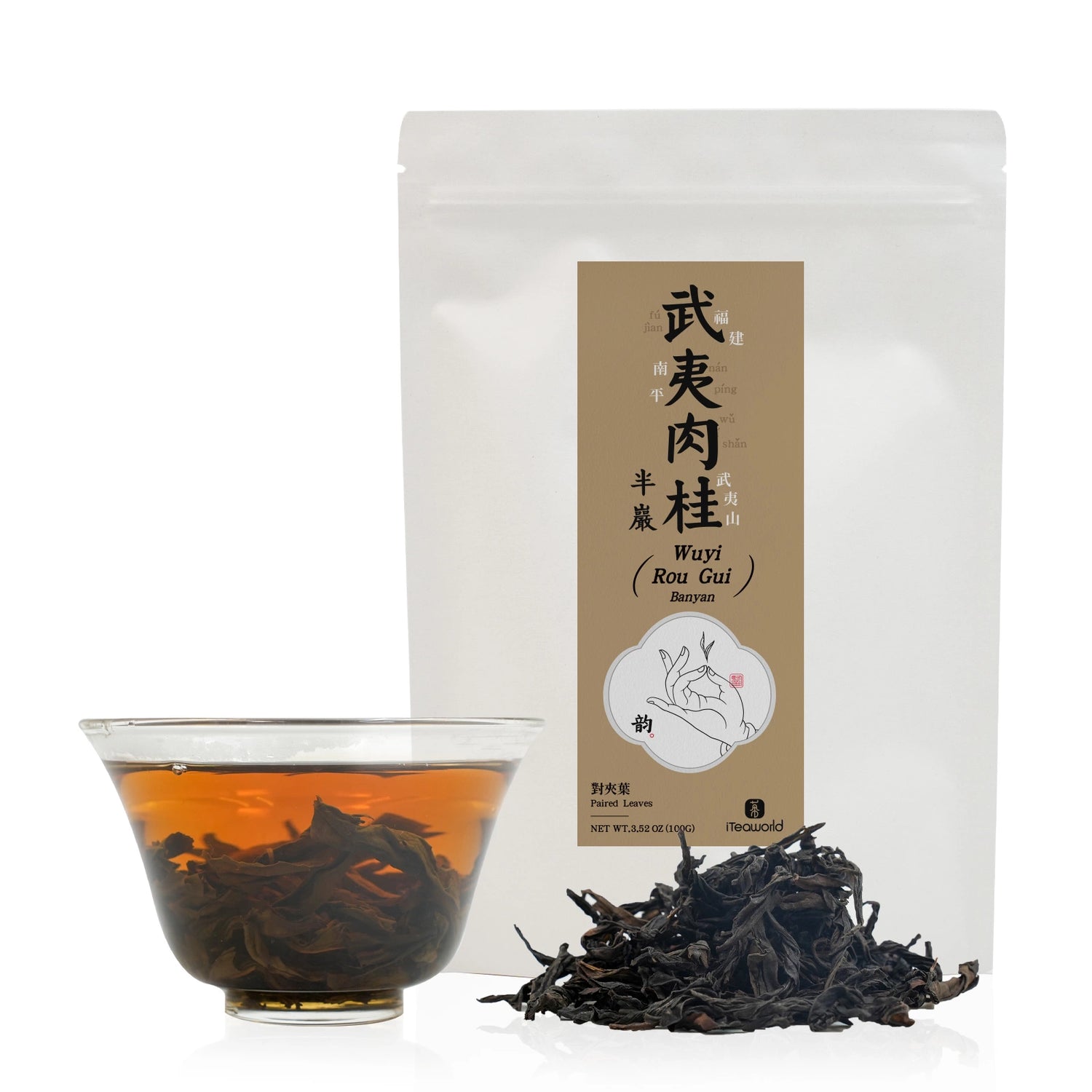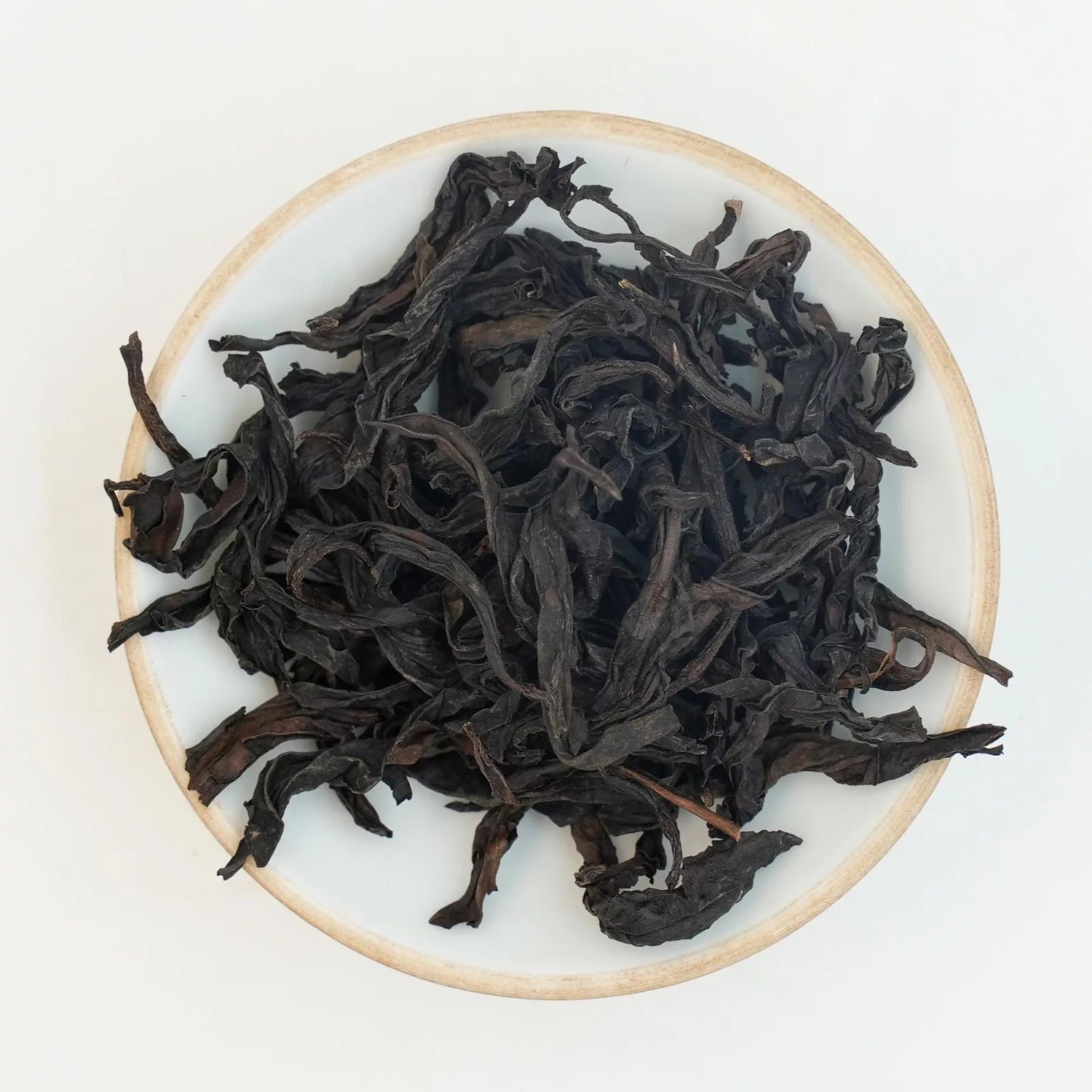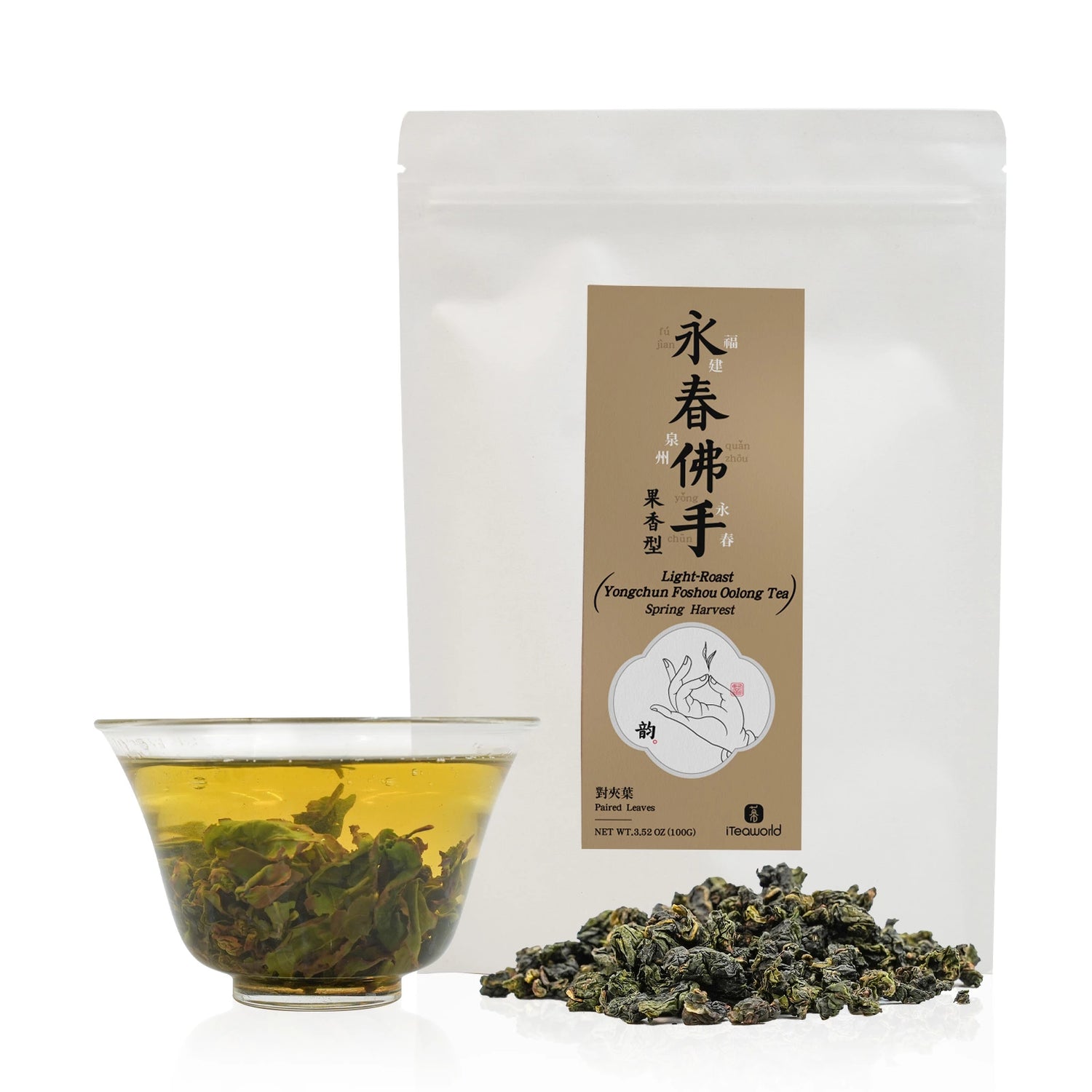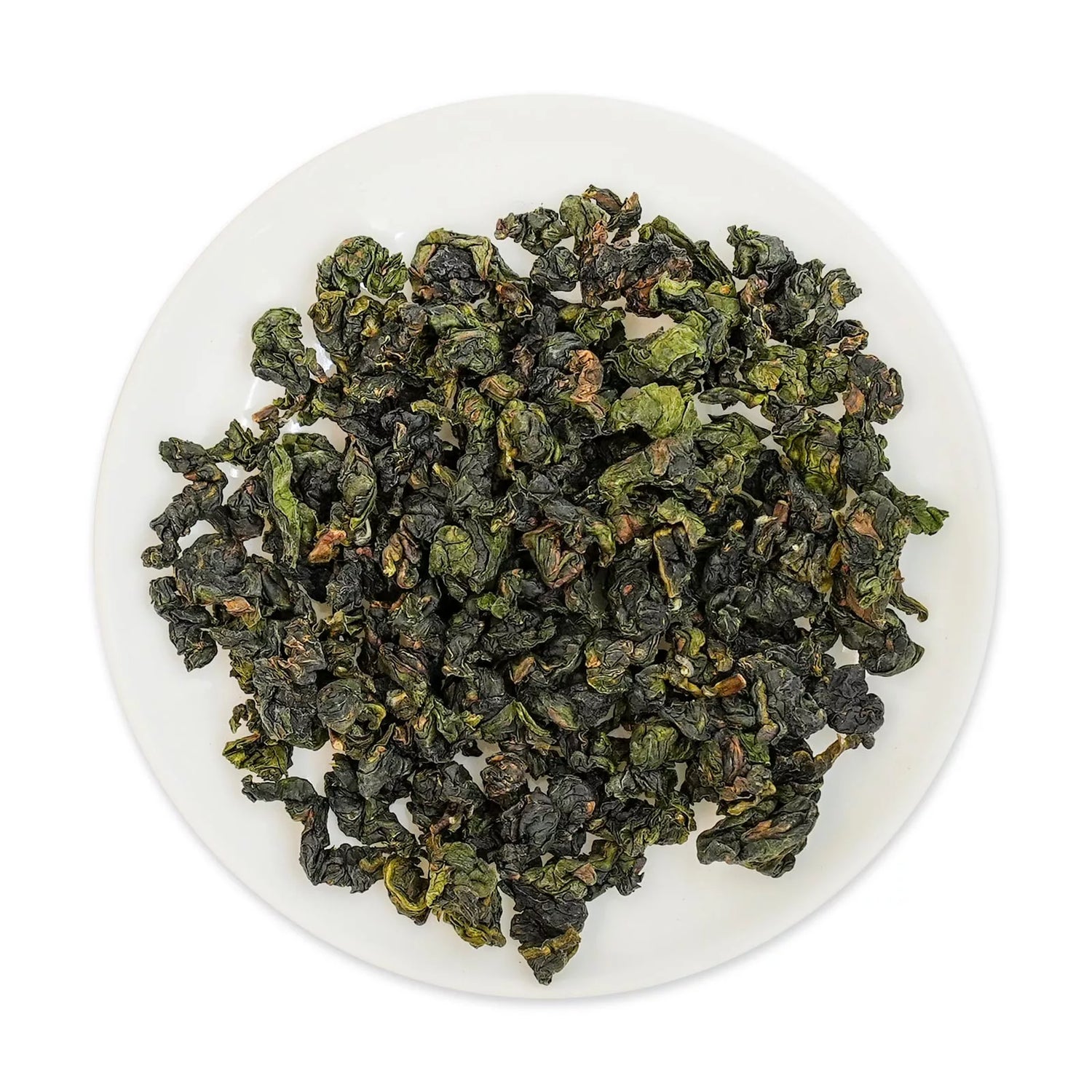Sort by:
204 products
204 products
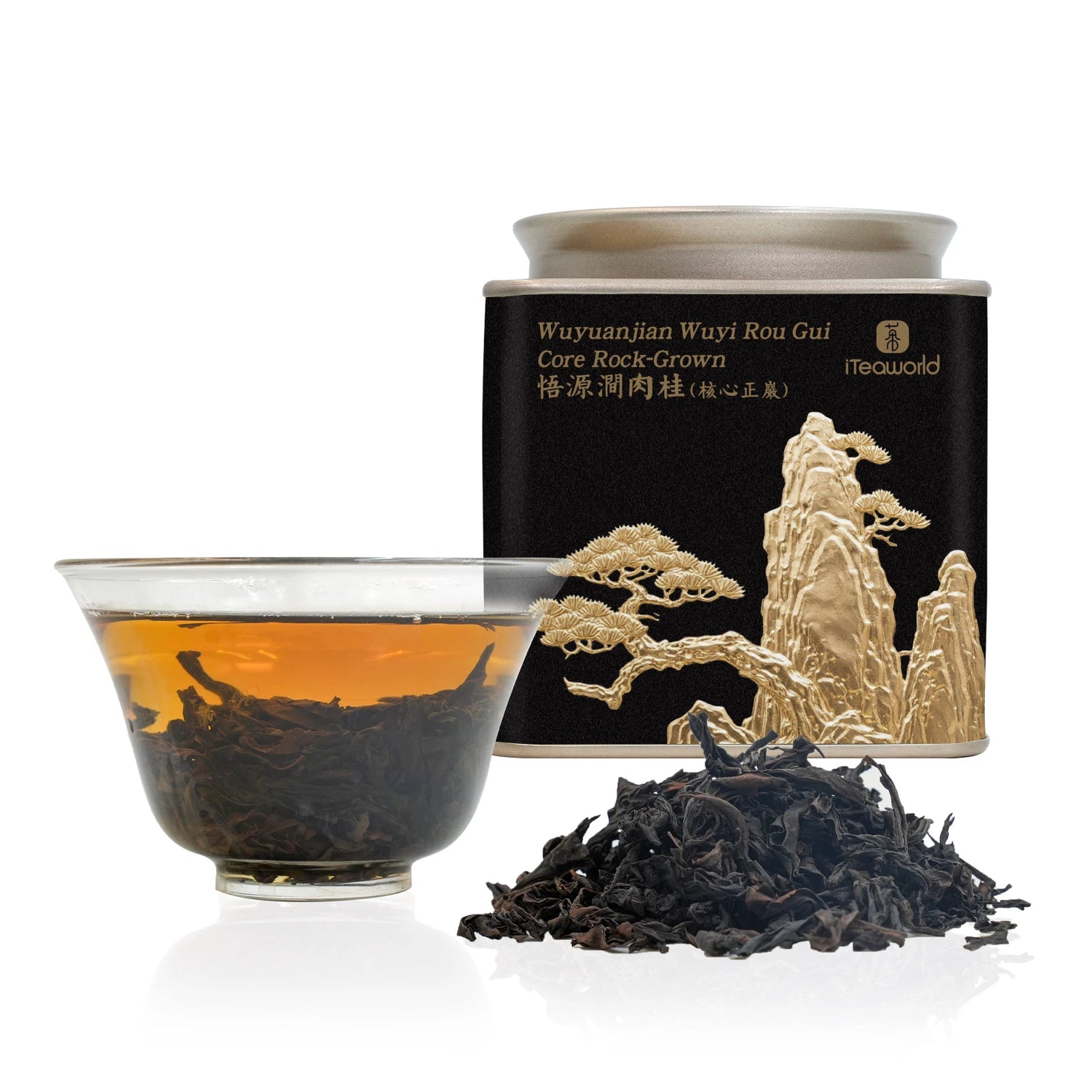

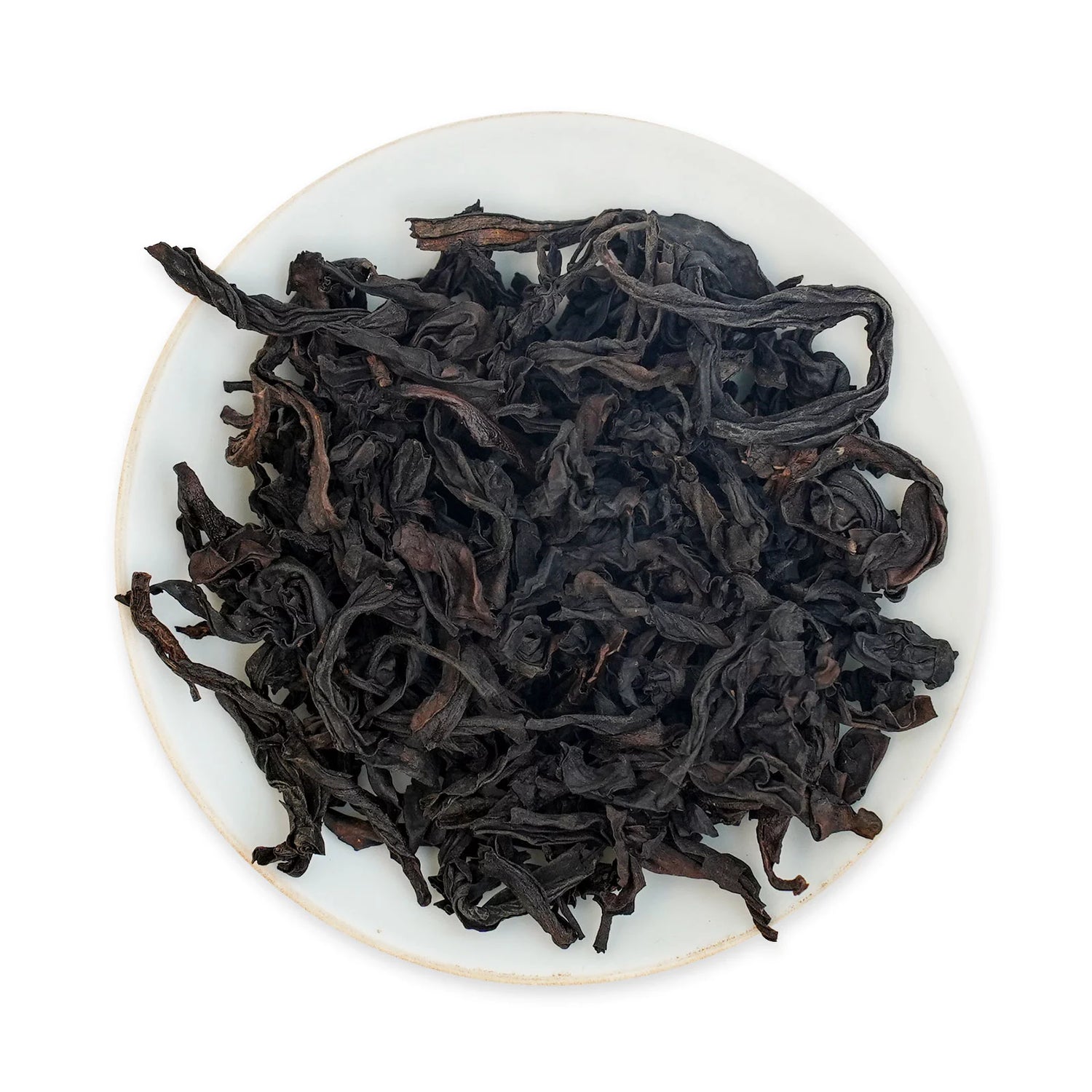
Top Grade Wuyi Rock Tea Wuyi Rougui - Core Zhengyan (Wuyuanjian) 50g
Top Grade Wuyi Rock Tea Wuyi Rougui - Core Zhengyan (Wuyuanjian) 50g
Wuyuanjian is one of the core Zhengyan producing areas of Wuyi Rock Tea, belonging to the famous “Three Pits and Two Ravines,” and is one of the two ravines. The area is shrouded in mist throughout the year, nourished by flowing streams, with a humid climate and soil rich in fine sandy gravel and minerals. Lush vegetation and this unique terroir together give birth to outstanding Wuyi Rock Teas. Among them, Rougui and Shui Xian from Wuyuanjian are especially prized for their rich fruity notes, elegant orchid fragrance, and full-bodied taste.
The Wuyi Rougui from Wuyuanjian reveals a clear and vivid cinnamon aroma at first, followed by subtle layers of orchid, woody undertones, and even a refreshing hint of mint. The fragrance is pure, distinctive, and lingers gracefully. The liquor is smooth and delicate on the palate, gradually unfolding into depth and the signature “rock rhyme.” Compared to Rougui from Niu Lan Keng, Wuyuanjian’s expression is softer and more refined—ideal for tea lovers who seek a fresh, elegant style.
Origin: Wuyuanjian, Xingcun Town, Wuyishan City, Fujian Province, China
Type: Core Zheng Yan (Core True Rock)
Tea Variety: Wuyi Rougui
Producer: Chen Hui
Harvest: October 2024
Aging: 36 months
Brewing Guide:
-
Water Temperature: 100°C (212°F)
-
Brewing Vessel: Gaiwan or Yixing Clay Teapot
-
Tea-to-Water Ratio: 5–7g per 100ml
-
Infusions:
1–3 infusions: 8–15 sec
Later infusions: +5–10 sec per infusion
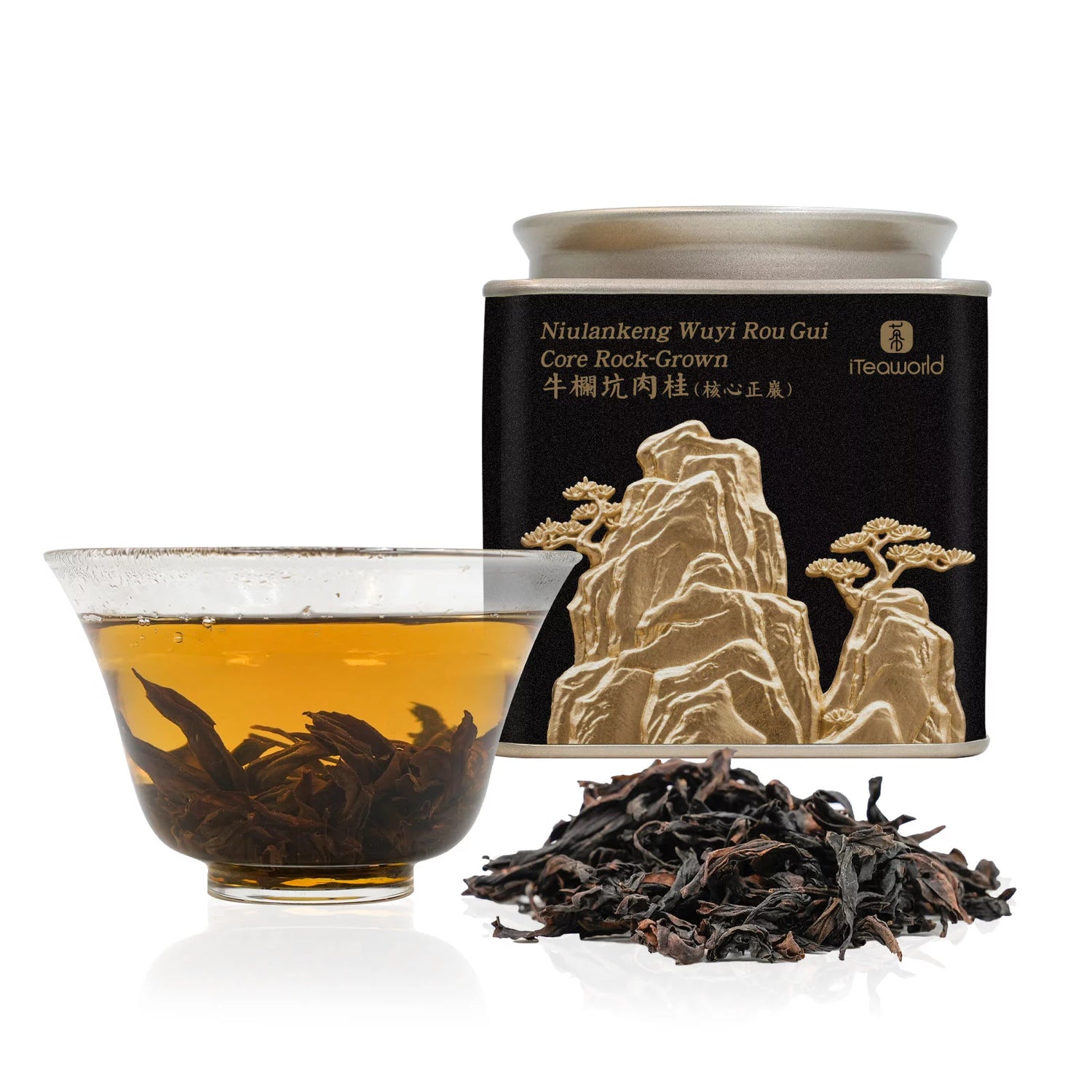

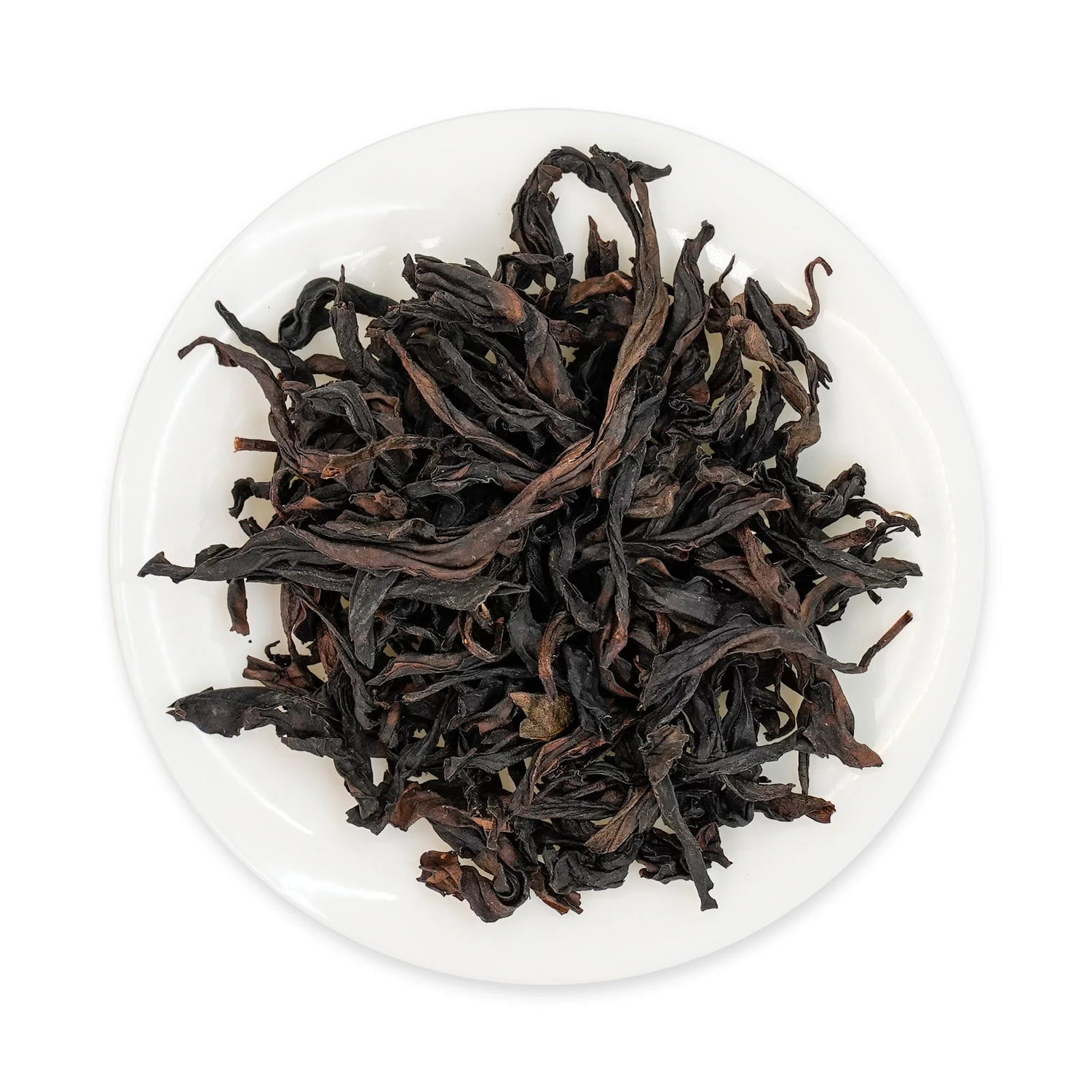
Top Grade Wuyi Rock Tea Wuyi Rougui - Core Zhengyan (Niu Lan Keng) 50g
Top Grade Wuyi Rock Tea Wuyi Rougui - Core Zhengyan (Niu Lan Keng) 50g
Niu Lan Keng is one of the core Zhengyan producing areas of Wuyi Rock Tea, belonging to the famous “Three Pits and Two Ravines.” The area is nourished year-round by flowing streams from rock crevices, with high humidity, misty air, limited sunlight inside the pit, and mineral-rich soil. These conditions create a cool, shaded environment ideal for tea trees.
The Wuyi Rougui produced here—often referred to as “Niu Rou”—is highly prized for its rarity and extremely limited yield, earning it the title “King of Rock Tea.” Its signature cinnamon note is sharp, bold, and highly penetrating, layered with osmanthus, floral, and fruity aromas. Unique to Niu Lan Keng, it also carries a distinct “ravine character”—a mossy, mineral freshness reminiscent of a primeval forest—which adds depth and authenticity to its terroir expression.
On the palate, it strikes a balance of strength and finesse: the cinnamon’s spicy sharpness is complemented by a smooth, delicate liquor, hiding inner power. The rock rhyme is pronounced, with a quick and lasting sweet aftertaste.
Origin: Niulankeng, Xingcun Town, Wuyishan City, Fujian Province, China
Type: Core Zheng Yan (Core True Rock)
Tea Variety: Wuyi Rougui
Producer: Chen Hui
Harvest: October 2024
Aging: 36 months
Brewing Guide:
-
Water Temperature: 100°C (212°F)
-
Brewing Vessel: Gaiwan or Yixing Clay Teapot
-
Tea-to-Water Ratio: 5–7g per 100ml
-
Infusions:
1–3 infusions: 8–15 sec
Later infusions: +5–10 sec per infusion
Matouyan is one of the top producing areas of Zhengyan Wuyi Rock Tea, located adjacent to Wuyuanjian. With open terrain, ample sunlight, and purple sandy-gravel soil ideal for growing Rougui and other tea trees, it is renowned for producing exceptional teas. The Rougui from Matouyan, often called “Ma Rou”, is prized as a luxury among Rock Teas for its sharp cinnamon aroma and full-bodied taste.
This Wuyi Rougui from Matouyan features a vivid, intense cinnamon fragrance. The liquor is rich, smooth, and full-bodied, with a subtle spicy note on the tip of the tongue, followed by a sweet aftertaste and pronounced rock rhyme (mineral character). Overall, it is bold, powerful, and commanding in style.
Origin: Matouyan, Xingcun Town, Wuyishan City, Fujian Province, China
Type: Zheng Yan (True Rock)
Tea Variety: Wuyi Rougui
Producer: Chen Hui
Harvest: August 2025
Aging: 36 months
Brewing Guide:
-
Water Temperature: 100°C (212°F)
-
Brewing Vessel: Gaiwan or Yixing Clay Teapot
-
Tea-to-Water Ratio: 5–7g per 100ml
-
Infusions:
1–3 infusions: 8–15 sec
Later infusions: +5–10 sec per infusion
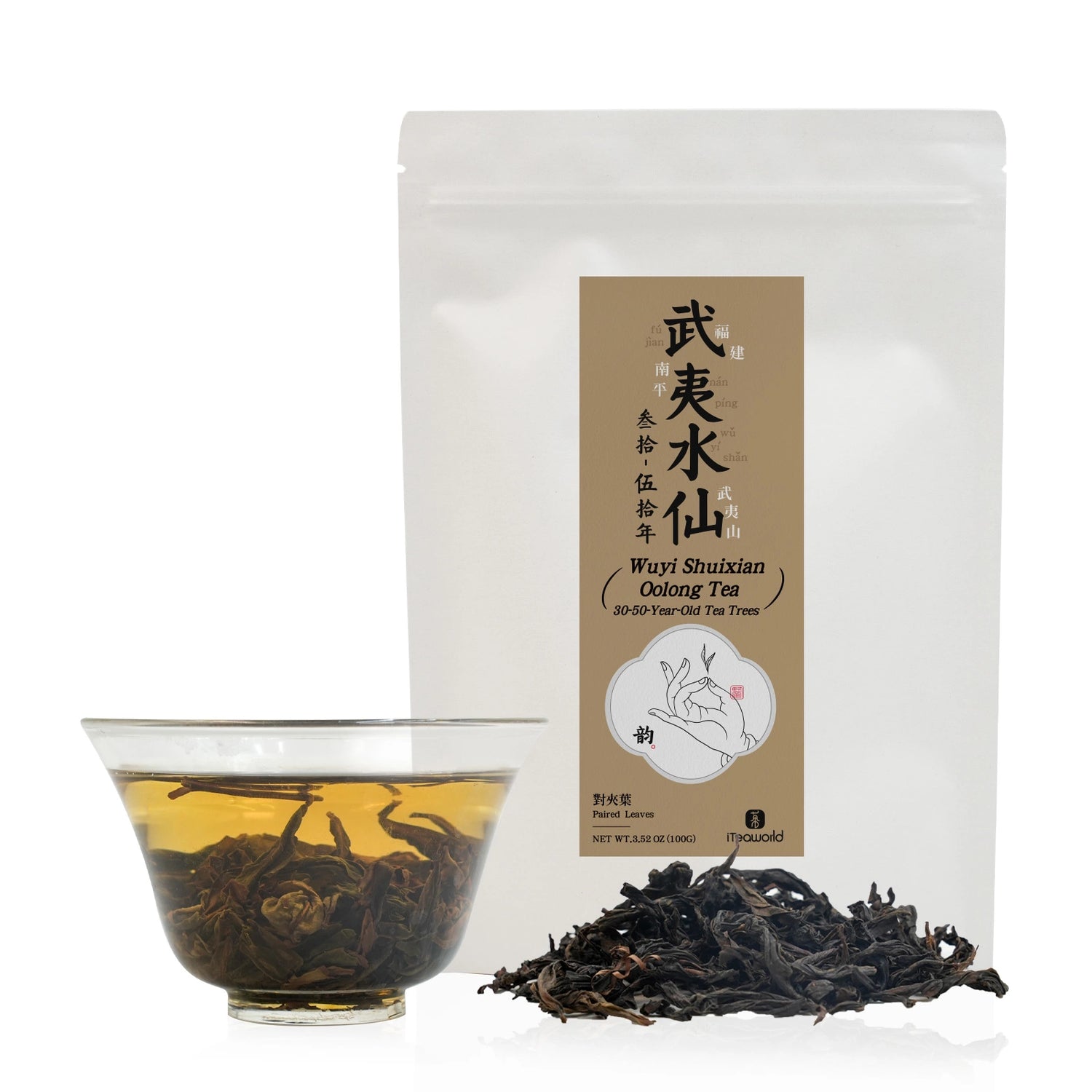
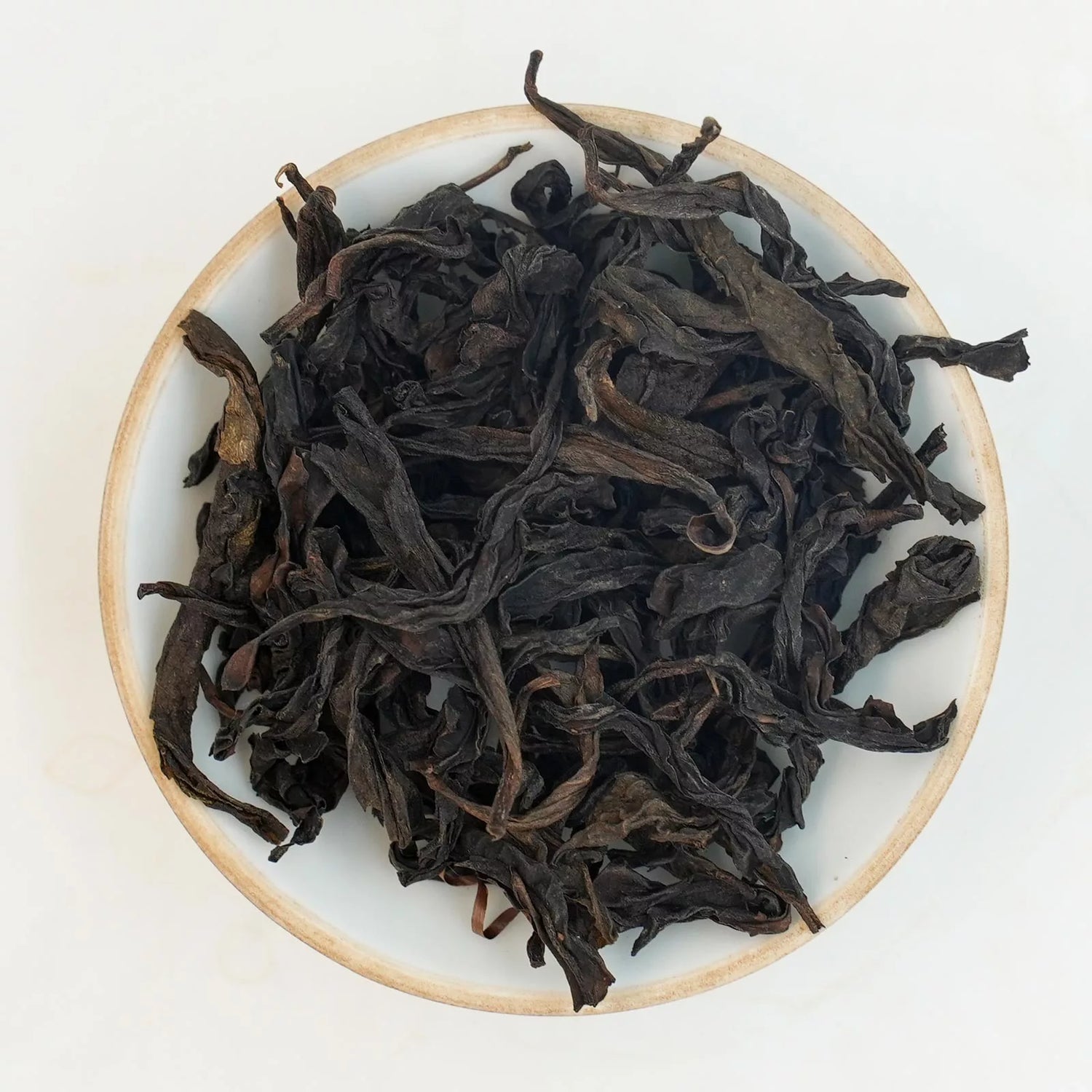
Premium Wuyi Rock Tea Wuyi Shui Xian - Banyan (30–50 Year Trees) 100g
Premium Wuyi Rock Tea Wuyi Shui Xian - Banyan (30–50 Year Trees) 100g
Wuyi Shui Xian is one of the most famous varieties of Wuyi Rock Tea. Alongside Rougui, it is famed for the saying: “No tea more mellow than Shui Xian, no tea more fragrant than Rougui.” It combines the classic rock character with rock rhyme and a rich, full-bodied liquor. Originally introduced from Jianyang during the Qing Dynasty, Wuyi Shui Xian places great emphasis on tree age: as the trees grow older, the tea becomes more mellow, with reduced bitterness and increasingly complex layers of flavor.
This Wuyi Shui Xian is made from fresh leaves of tea trees aged 30–50 years and roasted using traditional Wuyi charcoal methods. The liquor is rich and full-bodied, moderately intense with a slight astringency, a clear and lasting sweet aftertaste, and a subtle woody fragrance. The texture is smooth and refined, offering depth and complexity that invites slow, mindful tasting.
Origin: Daan Village, Yangzhuang Township, Wuyishan City, Fujian Province, China
Tree Age: 30–50 years
Type: Ban Yan (Half-Rock)
Tea Variety: Wuyi Shui Xian
Producer: Chen Hui
Harvest: May 2024
Aging: 36 months
Brewing Guide:
-
Water Temperature: 100°C (212°F)
-
Brewing Vessel: Gaiwan or Yixing Clay Teapot
-
Tea-to-Water Ratio: 5–7g per 100ml
-
Infusions:
1–3 infusions: 8–15 sec
Later infusions: +5–10 sec per infusion
Jin Mudan (Golden Peony) was developed by the Tea Research Institute of Fujian Academy of Agricultural Sciences between 1978 and 2002 through hybridization of Tieguanyin (female parent) and Huang Ti (Huang Jingui, male parent). Its name comes from the dark, glossy appearance of the dry leaves and the golden color of the leaf buds. Jin Mudan combines the “flavor” of Tieguanyin and the “fragrance” of Huang Jingui.
This Jin Mudan features a vivid, rich aroma with floral notes blending orchid and honey fragrance, which lingers even in a cold brew. The liquor is full-bodied, smooth, and delicate, with a distinct mineral taste ( rock rhyme ) and a long-lasting finish. It is often used to enhance the aroma when blending Da Hong Pao or enjoyed as a high-fragrance single-origin tea.
Origin: Jingshui Village, Xingcun Town, Wuyishan City, Fujian Province, China
Category: Ban Yan (mid-mountain, 400–600 m)
Soil: Gravel soil
Variety: Jin Mudan
Producer: Chen Hui
Harvest Time: November 2024
Shelf Life: 36 months
Brewing Guide
-
Water Temperature: 100°C (212°F)
-
Brewware: Gaiwan, Yixing clay teapot
-
Tea-to-Water Ratio: 5–7 g per 100 ml
-
1st–3rd Infusions: 8–15 seconds
-
Later Infusions: Add 5–10 seconds each time
One of Wuyi’s Four Famous Bushes, Ban Tian Yao is a rare and treasured tea, especially among seasoned tea drinkers. According to legend, during the Ming Dynasty, the abbot of Tianxin Temple dreamed of a white falcon being chased by a giant eagle. In its escape, the falcon dropped a glowing gemstone, which fell onto a cliffside. Later, monks discovered a tea plant growing there and carefully nurtured it. Because of its mysterious origin and ever-changing aroma, they named it “Ban Tian Yao”—meaning “Spirit Above the Clouds.”
This tea offers an evolving fragrance with each infusion. It starts with orchid and honey notes, followed by roasted almond and herbal aromas, finishing with a cool, delicate hint of plum blossom. The golden liquor is smooth and full-bodied, with a deep Yan Yun (rock rhyme) and a long, sweet aftertaste. Compared to Shuixian, it is more refined; less spicy than Rougui.
Origin: Jingshui Village, Xingcun Town, Wuyishan City, Fujian Province, China
Category: Ban Yan (mid-mountain, 400–600 m)
Soil: Gravel soil
Variety: Ban Tian Yao
Producer: Chen Hui
Harvest Time: November 2024
Shelf Life: 36 months
Brewing Guide
-
Water Temperature: 100°C (212°F)
-
Brewware: Gaiwan, Yixing clay teapot
-
Tea-to-Water Ratio: 5–7 g per 100 ml
-
1st–3rd Infusions: 8–15 seconds
-
Later Infusions: Add 5–10 seconds each time
Tie Luo Han is one of the four famous Wuyi Rock Tea cultivars. Its origin is said to be either Guidong or Zhuke, both located in the core Zhengyan areas of the Wuyi Mountains. In Southeast Asia, many experienced tea lovers highly esteem Tie Luo Han, sometimes even above Da Hong Pao.
This Tie Luo Han is crafted using traditional Wuyi Rock Tea techniques. The liquor opens with a rich floral aroma, followed by a subtle herbal note in the finish. The flavor is full-bodied and mellow, with a smooth, rice-like texture. Its rock character is pronounced, offering distinct mineral notes and a unique warmth. Ideal for tea enthusiasts looking to explore the depth and variety of Wuyi Rock Teas.
Origin: Jingshui Village, Xingcun Town, Wuyishan City, Fujian Province, China
Category: Ban Yan (mid-mountain, 400–600 m)
Soil: Gravel soil
Variety: Tie Luo Han
Producer: Chen Hui
Harvest Time: November 2024
Shelf Life: 36 months
Wuyi Rougui is one of the most famous varieties of Wuyi Rock Tea, named for its sharp, cinnamon-like aroma.
This Wuyi Rougui is medium charcoal-roasted. While its aroma and complexity are slightly less pronounced than core Zhengyan Rougui, the cinnamon fragrance is sharp and direct, filling the nose with the first infusion. The flavor is rich and full-bodied, with a slightly stimulating character and a touch of bitterness in the liquor. The sweet aftertaste and mouthwatering effect appear quickly, accompanied by a noticeable mineral character.
Compared to core Zhengyan Rougui, this Wuyi Rougui is an excellent choice for beginners exploring Rock Tea. It offers high value while retaining the distinctive features of Wuyi Rock Tea.
Origin: Jingshui Village, Xingcun Town, Wuyishan City, Fujian Province, China
Category: Ban Yan (mid-mountain)
Soil: Gravel soil
Variety: Wuyi Rou Gui
Producer: Chen Hui
Harvest Time: November 2024
Shelf Life: 36 months
Yongchun Fo Shou
Yongchun Fo Shou is a rare oolong from the high mountains of Yongchun County, Fujian. Its name comes from the leaf shape—resembling the Buddha’s hand citrus—and its bright, fruity aroma.
Legend says Buddhist monks in the 17th century grafted a tea tree onto a citron plant, creating this uniquely fragrant cultivar. Grown between 600–900 meters in Wuxi village near the protected origin region, this tea reflects both rich history and high mountain character.
It’s known for its distinctive citrus and pear notes, rounded out by a creamy, slightly floral finish. The taste is smooth and layered, with a lingering sweetness often described as the “Fo Shou charm.” Whether brewed hot or cold, this tea is a peaceful, full-bodied choice for those who enjoy fruity, elegant oolongs.
-
Origin: Wuxi Village, Wufeng Town, Yongchun County, Quanzhou, Fujian, China
-
Tea Maker: Xu Yongyuan
-
Harvest: 2025
-
Shelf Life: 36 months
-
Cultivar: Yongchun Fo Shou
-
Elevation: 500 meters
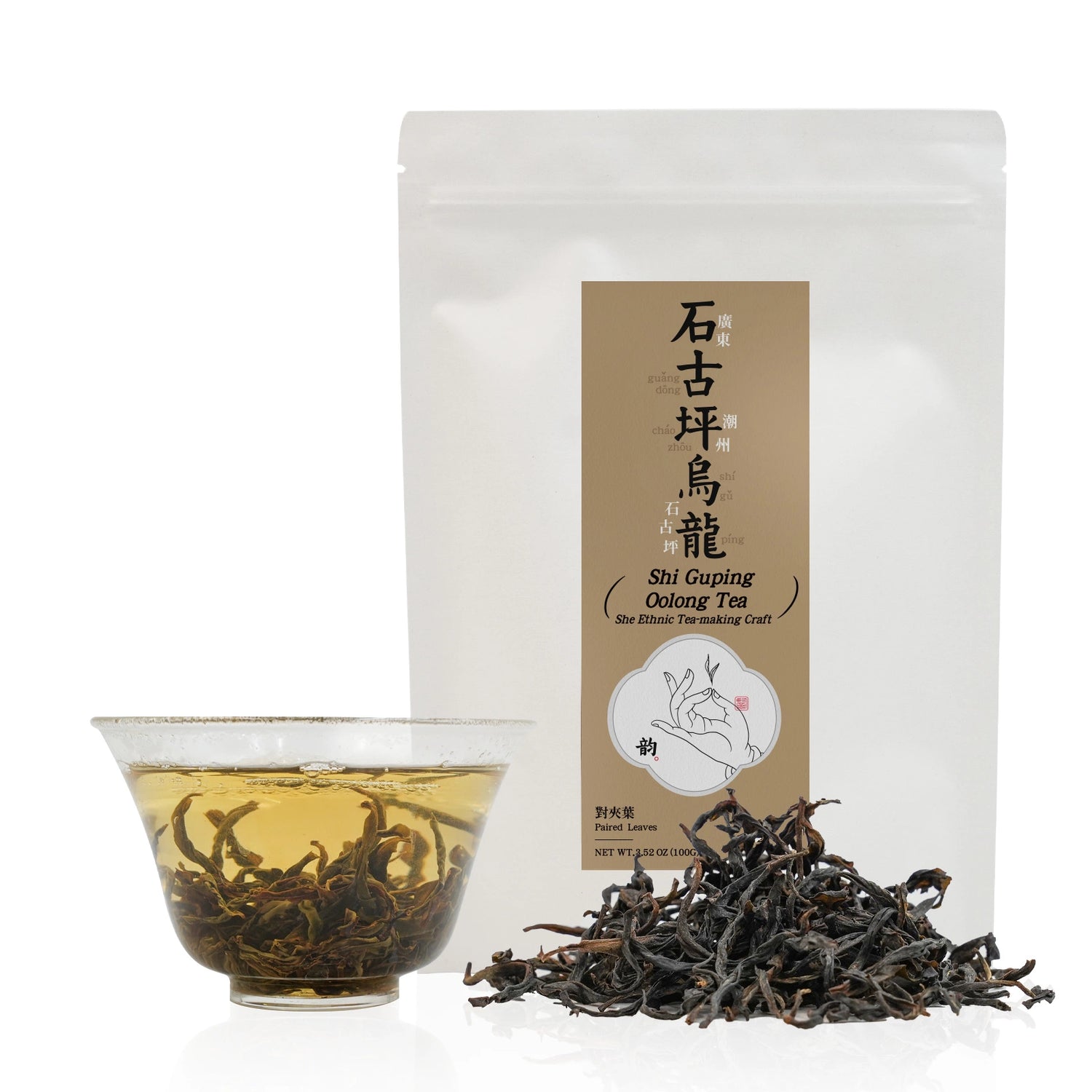

Premium Shiguping Oolong – Wild Phoenix Tea with Aged Pu’er Notes 50g 2025
Premium Shiguping Oolong – Wild Phoenix Tea with Aged Pu’er Notes 50g 2025
Shiguping Oolong | The Wild Soul of Hakka Craft
A Rare Indigenous Cultivar with Ethnic Roots
Shiguping oolong is made from a local, indigenous tea cultivar traditionally cultivated by the She people, a minority ethnic group native to this part of Guangdong. Unlike the widely used Phoenix Shui Xian cultivar, this tea comes from a separate genetic lineage, maintained for generations in Shiguping Village.
The tea plants here are broadleaf shrubs, not arbor trees, and have adapted to volcanic soils and mountain mists. Their leaves are thicker and more polyphenol-rich than Phoenix cultivars, giving the tea a wilder, more mineral-driven taste—distinct from the fragrant and delicate Dancong varieties grown elsewhere in Fenghuang.
Flavor Note
A rare oolong with a mellow, grounding taste—low in aroma but high in sweetness and complexity. Though freshly made, it already shows a flavor style similar to a lightly aged raw pu-erh (around 2–3 years): soft, gently fruity. Unlike most Guangdong oolongs, this tea does not focus on floral fragrance, but offers a smooth, deep sweetness and strong aging potential.
Origin: Shiguping Village, Fenghuang Town, Chaozhou, Guangdong, China
Cultivar: Shiguping Group-Varietal / Bird Beak Tea
Elevation: 400–600m
Tree Age: ~50 years
Roast: Longan wood charcoal roast
Storage: Ages well over time (ideal shelf life 36+ months)
Origin & Terroir: “Low Mountains, High Tea”
Though its elevation is only 400–600m, Shiguping’s volcanic soil, dense fog (200 days/year), and dramatic day-night temperature swings create an exceptional microclimate. Tea trees here grow slowly, developing richer amino acids and aromatic compounds. This unique environment produces unexpected richness usually reserved for higher elevations.
A Wild Cultivar with a Fierce Personality
Shiguping oolong is made from a local group-varietal known as “Bird Beak Tea”, with thick leaves and 15% higher polyphenol content than Phoenix Shui Xian. Descended from Shui Xian but diverging through natural mutation, it expresses a wilder, more rugged flavor than cultivated Dancong types.
Hakka-Style Processing: Intense, Ancestral, Authentic
This tea follows a late-Qing dynasty Hakka method of:
-
Heavier tossing (三碰三晾) during oxidation
-
35–40% fermentation, close to northern Fujian-style oolongs
-
12+ hours charcoal roast using longan wood
The result? A complex aroma of roasted fruit and deep charcoal, with a flavor much more intense and aged than typical Phoenix teas.
Flavor: From Fire to Fruit to Sweetness
This tea delivers a three-stage taste experience:
-
First infusions: roasted, toasty notes like Wuyi rock teas
-
Mid infusions: tart-sweet flavor of preserved plums
-
Final steeps: mellow sugarcane sweetness
It’s bold, complex, and full of contrast—a tea that evolves in your cup and lingers on the mind.
For Aging, It’s in a League of Its Own
Historically exported from Shantou in the 19th century and used in Southeast Asian medicinal tea blends, Shiguping oolong is prized for its aging potential. Rich in polyphenols, it ages nearly twice as fast as Dancong, developing woody and medicinal notes over time.
“Three years becomes medicine. Ten years becomes treasure.”
A 2010 batch reviewed in 2023 showed clear transformation to herbal aroma, while most Dancong from the same year only showed mild honey notes.
Brewing Recommendations
Gongfu Style (Recommended):
-
5–6g tea per 100–150ml gaiwan
-
Water temp: 95–98°C / 203–208°F
-
Quick rinse, then steep 6–8+ times
-
Start at 10–15 sec per infusion and adjust to taste
Western-style Brewing:
-
2g per 100ml water
-
95°C (203°F), 2–3 minutes steep
-
Re-steep up to 2–3 times
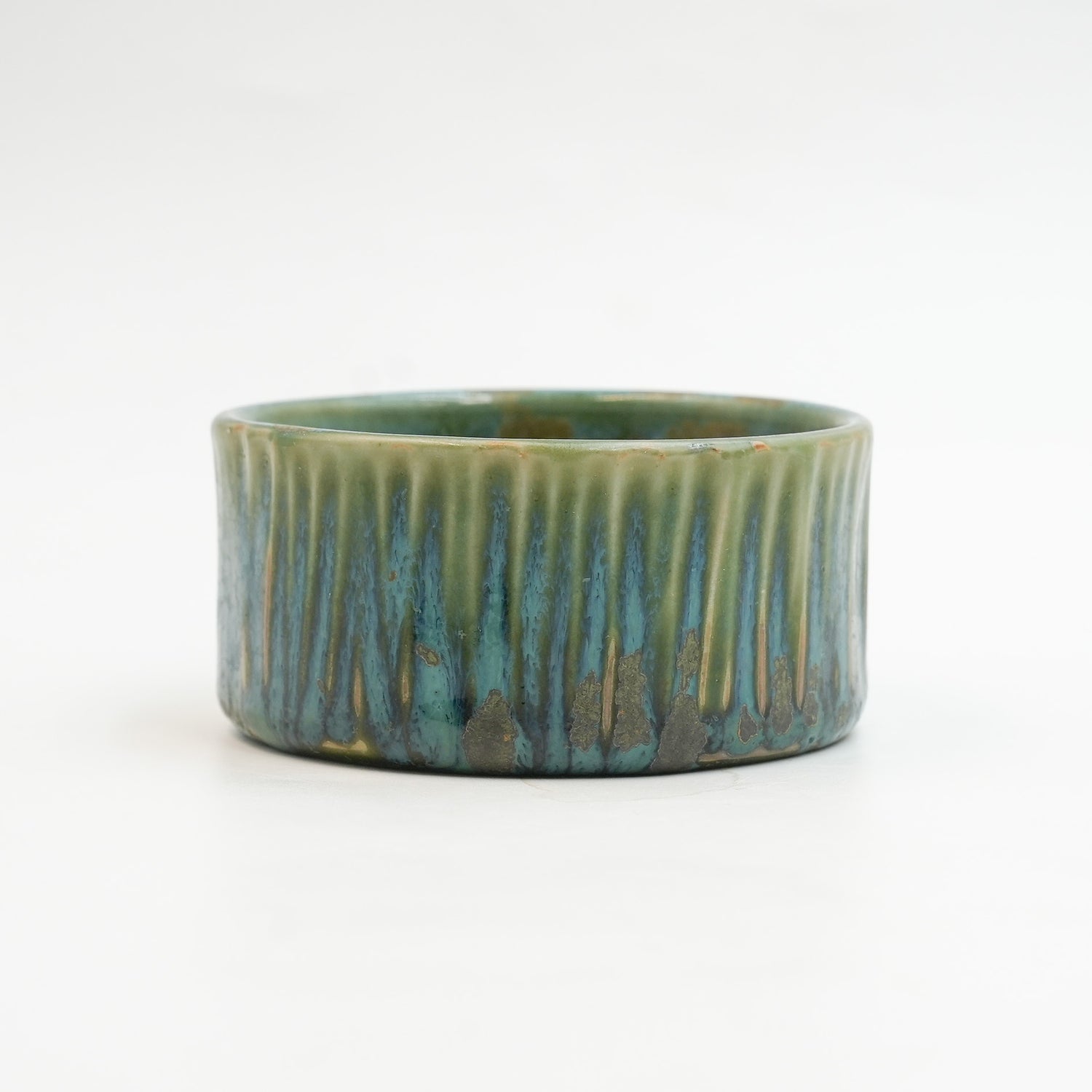

【 One of a Kind】Jun ware tea cup-handmade pine green striped master cup-90ml
【 One of a Kind】Jun ware tea cup-handmade pine green striped master cup-90ml
Product Description:
This tea set is a Jun porcelain teacup. The stripes on the teacup are hand-made and fired at high temperature to create a beautiful pine green color.
Note: Each piece is handmade. The glaze result is unpredictable, ensuring no two pieces are exactly alike.
Key Information:
Artisan: Wang Xile (王喜乐)
Dimensions: Width 8cm × Height 4cm
Capacity: 90ml
Weight: 175g
Jun Ware:
Jun ware is a rare Chinese ceramic art, once reserved for emperors. Its magic lies in kiln transmutation—each piece develops unique, unpredictable shades of blue, purple, and red during high-temperature firing. No two are ever alike, making every piece a one-of-a-kind masterpiece of fire and craftsmanship.
Recommended purchase:
For tea lovers: a handcrafted teaware that elevates the tea drinking experience.
For art collectors: a unique masterpiece that will never be replicated.
For interior design: an upgrade to any modern or classic space.
Artisan Profile:
Xile Wang is a seasoned artisan in contemporary Jun porcelain, renowned for his expertise in teaware creation, particularly in the art of traditional charcoal firing. He is widely recognized as a "Master of Teapot Art."
Wang specializes in designing and crafting Jun porcelain teaware, integrating ancient charcoal-firing techniques with the natural beauty of kiln transmutation. His works feature rich, rustic glazes and distinctive textures, exemplified in teapot series such as the "Ancient Tree Teapot," "High Pear Teapot," and "Bamboo Knot Teapot." Characterized by elegant, flowing forms, his creations strike a balance between functionality and artistic expression.
Among his signature works, glaze variations like "Forbidden City Red," "Starry Sky Blue," and "Emerald Green" showcase the mesmerizing "One color before firing, a thousand variations after" charm of Jun porcelain.
Through his innovative application of charcoal firing, Wang has elevated Jun porcelain teaware craftsmanship, setting a new benchmark for the fusion of traditional techniques and modern aesthetics.
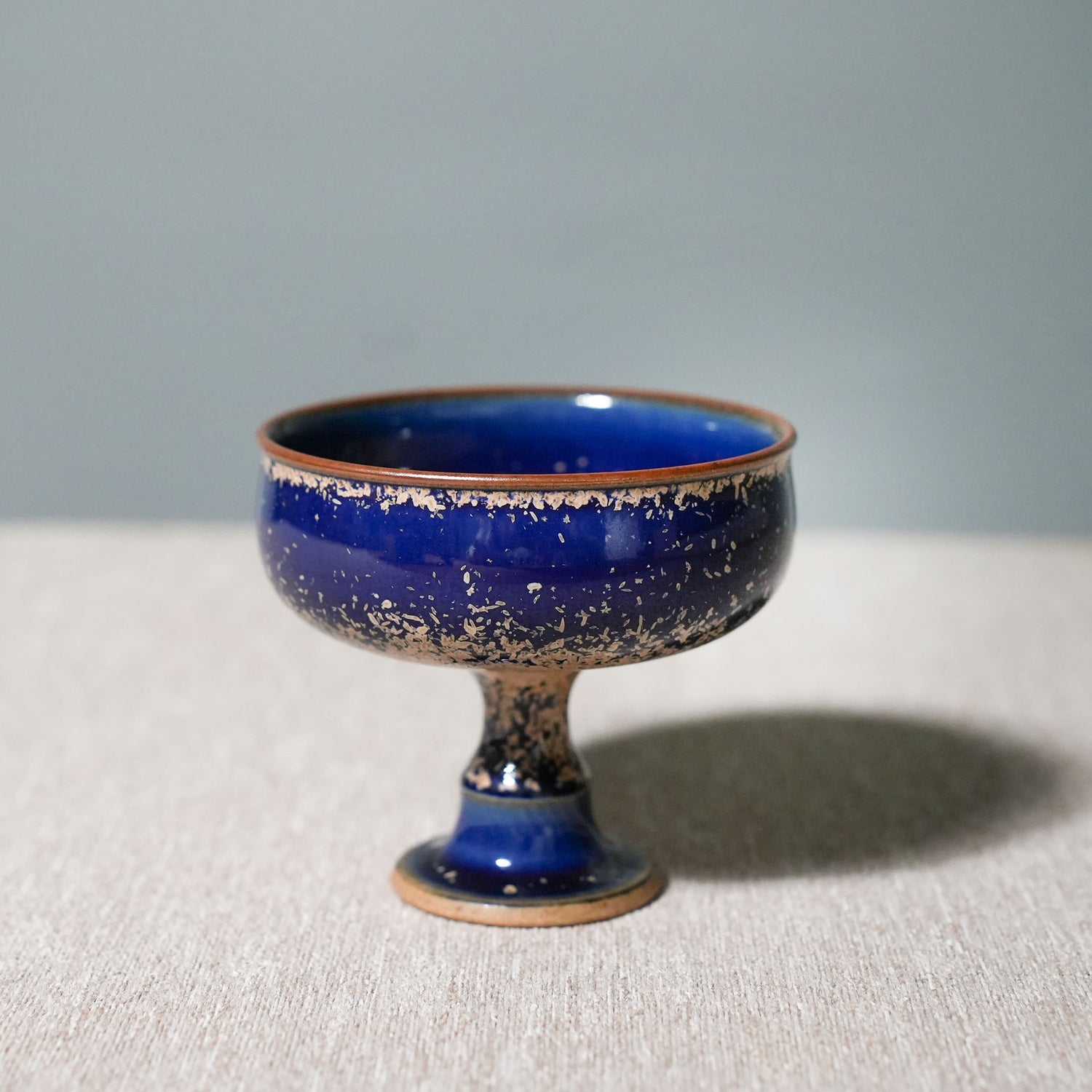

【 One of a Kind】Jun porcelain tea cup-starry blue goblet handmade-60ml
【 One of a Kind】Jun porcelain tea cup-starry blue goblet handmade-60ml
Product Description:
This tea set is a Jun porcelain stemmed teacup, shaped like a wine glass, with a kiln-transmuted glaze in a starry-sky blue hue. The thick ceramic body provides thermal insulation, ideal for tea tasting.
Note: Each piece is handmade. The glaze result is unpredictable, ensuring no two pieces are exactly alike.
Key Information:
Artisan: Cui Xiaoning (崔小宁)
Dimensions: Mouth Width 6.9cm × Height 6.2cm
Capacity: 60ml
Weight: 77g
Jun Ware:
Jun ware is a rare Chinese ceramic art, once reserved for emperors. Its magic lies in kiln transmutation—each piece develops unique, unpredictable shades of blue, purple, and red during high-temperature firing. No two are ever alike, making every piece a one-of-a-kind masterpiece of fire and craftsmanship.
Recommended purchase:
For tea lovers: a handcrafted teaware that elevates the tea drinking experience.
For art collectors: a unique masterpiece that will never be replicated.
For interior design: an upgrade to any modern or classic space.
Artisan Profile:
Xiaoning Cui is a key inheritor of contemporary Jun porcelain craftsmanship. Born into a family of porcelain artisans in Shenhou Town, the heart of Jun porcelain, he was immersed in its culture from an early age. Trained under Yinjian Zhong, a Henan Provincial Ceramic Art Master, Cui spent over a decade systematically mastering traditional techniques such as wheel throwing and glazing. After further refining his skills at Huajin Jun Kiln, he gained comprehensive expertise in Jun porcelain firing. In 2019, he founded Qiande Jun Kiln, where he serves as Artistic Director, focusing on Jun porcelain teaware. His work blends classical kiln transmutation artistry with modern aesthetics, renowned for its elegant forms and vibrant glaze variations. Particularly in teaware design, he has developed a distinctive style. As both a practitioner and advocate of Jun porcelain’s intangible heritage, Cui continues to invigorate its tradition through kiln operation and technical innovation, ensuring its enduring legacy and evolution.

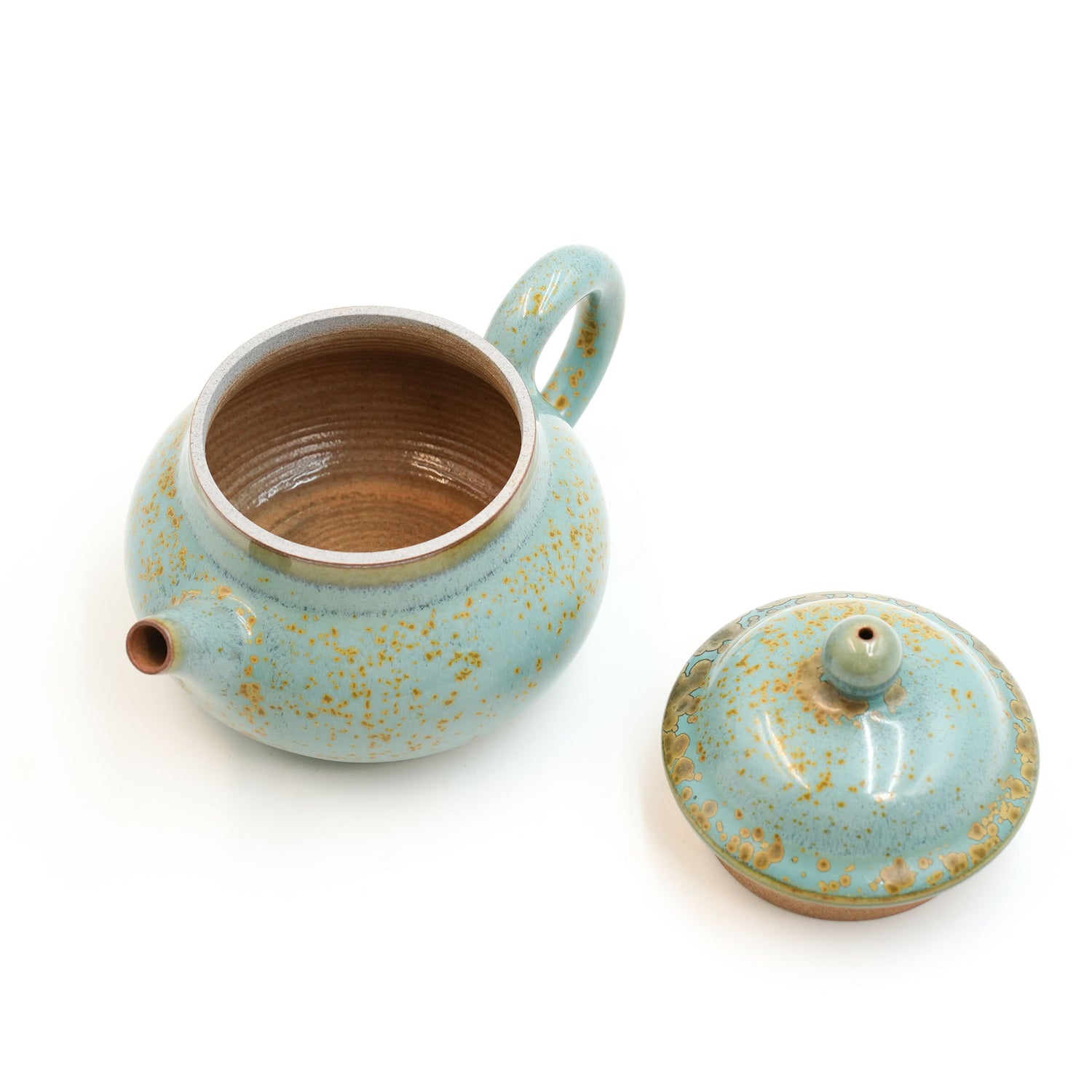
【 One of a Kind】Handmade Jun Ware – Turquoise Simple Chinese Teapot-185ml
【 One of a Kind】Handmade Jun Ware – Turquoise Simple Chinese Teapot-185ml
Product Description:
This tea set is a Handmade Jun Ware Chinese Minimalist Kungfu Teapot, featuring a turquoise glaze with scattered yellow oil-drop patterns and a rounded, compact, and adorable design.
Note: Each piece is handmade. The glaze result is unpredictable, ensuring no two pieces are exactly alike.
Key Information:
Studio: Shangyuan jun
Author: Yang Pengfei
Size: mouth width 3.8cm, overall height 9cm, length 12.8cm
Capacity: 185ml
Weight: 214g (7.5oz)
Jun Ware:
Jun ware is a rare Chinese ceramic art, once reserved for emperors. Its magic lies in kiln transmutation—each piece develops unique, unpredictable shades of blue, purple, and red during high-temperature firing. No two are ever alike, making every piece a one-of-a-kind masterpiece of fire and craftsmanship.
Recommended purchase:
For tea lovers: a handcrafted teaware that elevates the tea drinking experience.
For art collectors: a unique masterpiece that will never be replicated.
For interior design: an upgrade to any modern or classic space.
Artisan Profile:
Pengfei Yang, a Henan Province Ceramic Art Master and Xuchang Arts and Crafts Master, is a leading figure in contemporary Jun porcelain teapot artistry and a distinguished representative of Central China's teapot culture.
Trained under Kong Xiangqing, a Chinese Master of Arts and Crafts, Yang has dedicated over 20 years to perfecting Jun porcelain craftsmanship. In 2011, he founded Shangyuan Jun Kiln, pioneering the "Form-Glaze Integration" concept to revolutionize Jun porcelain teapot making. He overcame the traditional challenges of clay shrinkage and developed the unique "Square-Inch Kiln Transmutation" technique. By incorporating cultural elements from Liangzhu jade artifacts and Han-Wei bronzes into his teapot designs, he created masterpieces such as "Renhe Teapot" and "Han Tile Teapot," which have repeatedly won national honors like the China Arts and Crafts "Hundred Flowers Award."
Yang advocates for a creative philosophy of "Function as the foundation, aesthetics as the expression," driving Jun porcelain’s transformation from display pieces to lifestyle art. Recognized as the "Innovator of Central China's Teapot Art," he seamlessly bridges millennia-old kiln traditions with modern tea culture, allowing Jun porcelain to shine with contemporary brilliance within the delicate space of a teapot.


【 One of a Kind】Handmade Jun ware-purple blue glaze dragon head teapot-200ml
【 One of a Kind】Handmade Jun ware-purple blue glaze dragon head teapot-200ml
Product Description:
This tea set is a Jun porcelain "Dragon Head" teapot. The handle of the teapot is shaped like a dragon, and the lid handle is designed in the form of a dragon’s head. The design is inspired by the dragon motifs found in the Hongshan culture, dating back to 6500-5000 BC. The color features a beautiful kiln change effect, resembling meteorites falling, with a blue-green base and a reddish-purple top. The bottom of the teapot is engraved with the "Jun Shang Yuan" logo.
Note: Each piece is handmade. The glaze result is unpredictable, ensuring no two pieces are exactly alike.
Key Information:
Studio: Shangyuan Jun
Artist: Yang Pengfei
Dimensions: Mouth width 3.8 cm(1.5in), height 10.6 cm(4.1in), length 12.5 cm(4.9in)
Capacity: 200 ml
Weight: 220 g(7.76oz)
Jun Ware:
Jun ware is a rare Chinese ceramic art, once reserved for emperors. Its magic lies in kiln transmutation—each piece develops unique, unpredictable shades of blue, purple, and red during high-temperature firing. No two are ever alike, making every piece a one-of-a-kind masterpiece of fire and craftsmanship.
Recommended purchase:
For tea lovers: a handcrafted teaware that elevates the tea drinking experience.
For art collectors: a unique masterpiece that will never be replicated.
For interior design: an upgrade to any modern or classic space.
Artisan Profile:
Pengfei Yang, a Henan Province Ceramic Art Master and Xuchang Arts and Crafts Master, is a leading figure in contemporary Jun porcelain teapot artistry and a distinguished representative of Central China's teapot culture.Trained under Kong Xiangqing, a Chinese Master of Arts and Crafts, Yang has dedicated over 20 years to perfecting Jun porcelain craftsmanship. In 2011, he founded Shangyuan Jun Kiln, pioneering the "Form-Glaze Integration" concept to revolutionize Jun porcelain teapot making. He overcame the traditional challenges of clay shrinkage and developed the unique "Square-Inch Kiln Transmutation" technique. By incorporating cultural elements from Liangzhu jade artifacts and Han-Wei bronzes into his teapot designs, he created masterpieces such as "Renhe Teapot" and "Han Tile Teapot," which have repeatedly won national honors like the China Arts and Crafts "Hundred Flowers Award."Yang advocates for a creative philosophy of "Function as the foundation, aesthetics as the expression," driving Jun porcelain’s transformation from display pieces to lifestyle art. Recognized as the "Innovator of Central China's Teapot Art," he seamlessly bridges millennia-old kiln traditions with modern tea culture, allowing Jun porcelain to shine with contemporary brilliance within the delicate space of a teapot.
This Zhuni Teapot was handcrafted by Cai Songkai, a renowned Zhuni teapot master from Chaozhou. Made primarily from Zhuni clay, the teapot features an egg-shaped body, hence the name “Dragon Egg Teapot.”
In traditional Chinese culture, the egg symbolizes the origin of life and the primordial state of the universe — representing vitality and endless possibility. The dragon, on the other hand, is a symbol of good fortune and auspicious power. Together, the concept of the “Dragon Egg” conveys a blessing for prosperity, renewal, and good luck.
The artist’s name is engraved inside the lid and on the handle. The spout features a petal-like design, while the top of the lid is engraved with the Chinese character “王” (meaning “king”).
This teapot shape is ideal for high-aroma teas, especially Oolong teas such as Phoenix Dancong, Tieguanyin, and Dong Ding Oolong.
Capacity: 110 mL
What is a Zhuni Teapot?
Zhuni is a type of zisha clay, belonging to the “red clay” family, and is regarded as the finest and most delicate among them — often considered the “noble” or “gem” of zisha clay.
It has a low sand content and a fragile texture, making it prone to deformation or cracking during firing. Because of this, the yield rate is very low, and teapots made from it are known as Zhuni teapots.
Chaozhou Zhuni Master — Cai Songkai
Cai Songkai is a senior arts and crafts artist of Guangdong Province, a Chaozhou arts and crafts master, and a renowned folk ceramic artist.
With years of dedication to Zhuni pottery, he has developed a distinctive style that combines precise structure, smooth lines, and refined craftsmanship. His teapots are widely admired by collectors both in China and abroad, earning him a strong reputation in the field of Zhuni teapot making. His works have won multiple gold awards in major competitions.
This Zhuni Teapot was handcrafted by Cai Songkai, a renowned Zhuni teapot master from Chaozhou.
The design follows the “Shuiping” (Level) teapot concept, first created by Ming dynasty artisans. The idea centers on perfect balance — a rounded, full body with a stable center of gravity, allowing the teapot to remain level whether it floats or sinks when filled with water. This reflects the Eastern philosophy of harmony and balance — “peace through equilibrium, virtue through harmony.”
Structurally, the spout, lid rim, and handle top all align on the same horizontal plane, with the spout, lid, and handle forming a straight line. This precise geometry prevents external water from entering the teapot and ensures stability when placed in a bowl — hence the name “Shuiping Teapot.”
The artist’s surname or signature is engraved on the inside of the lid and the handle.
This teapot shape is particularly suitable for high-aroma teas, especially Oolong teas such as Phoenix Dancong, Tieguanyin, and Dong Ding Oolong.
Capacity: 80 mL
What is a Zhuni Teapot?
Zhuni is a type of zisha clay, belonging to the “red clay” family, and is regarded as the finest and most delicate among them — often considered the “noble” or “gem” of zisha clay.
It has a low sand content and a fragile texture, making it prone to deformation or cracking during firing. Because of this, the yield rate is very low, and teapots made from it are known as Zhuni teapots.
Chaozhou Zhuni Master — Cai Songkai
Cai Songkai is a senior arts and crafts artist of Guangdong Province, a Chaozhou arts and crafts master, and a renowned folk ceramic artist.
With years of dedication to Zhuni pottery, he has developed a distinctive style that combines precise structure, smooth lines, and refined craftsmanship. His teapots are widely admired by collectors both in China and abroad, earning him a strong reputation in the field of Zhuni teapot making. His works have won multiple gold awards in major competitions.
This Zhuni Teapot was handcrafted by Chaozhou master potter Cai Songkai, using Zhuni clay as the primary material. The teapot’s shape resembles an eggplant, inspired by the fruits and vegetables of the countryside — hence its name, Qiegua Hu (“Eggplant Teapot”). The artist’s surname or signature is engraved on the inside of the lid and the handle.
This teapot shape is ideal for brewing high-aroma teas, especially Oolong teas such as Phoenix Dancong, Tieguanyin, and Dong Ding Oolong.
Capacity: 80 mL
What is a Zhuni Teapot?
Zhuni is a type of zisha clay, belonging to the “red clay” family, and is regarded as the finest and most delicate among them — often considered the “noble” or “gem” of zisha clay.
It has a low sand content and a fragile texture, making it prone to deformation or cracking during firing. Because of this, the yield rate is very low, and teapots made from it are known as Zhuni teapots.
Chaozhou Zhuni Master — Cai Songkai
Cai Songkai is a senior arts and crafts artist of Guangdong Province, a Chaozhou arts and crafts master, and a renowned folk ceramic artist.
With years of dedication to Zhuni pottery, he has developed a distinctive style that combines precise structure, smooth lines, and refined craftsmanship. His teapots are widely admired by collectors both in China and abroad, earning him a strong reputation in the field of Zhuni teapot making. His works have won multiple gold awards in major competitions.
Recently viewed products
Chat with fellow tea lovers, ask questions, and share your tea moments.
Chat with fellow tea lovers, ask questions, and share your tea moments.





